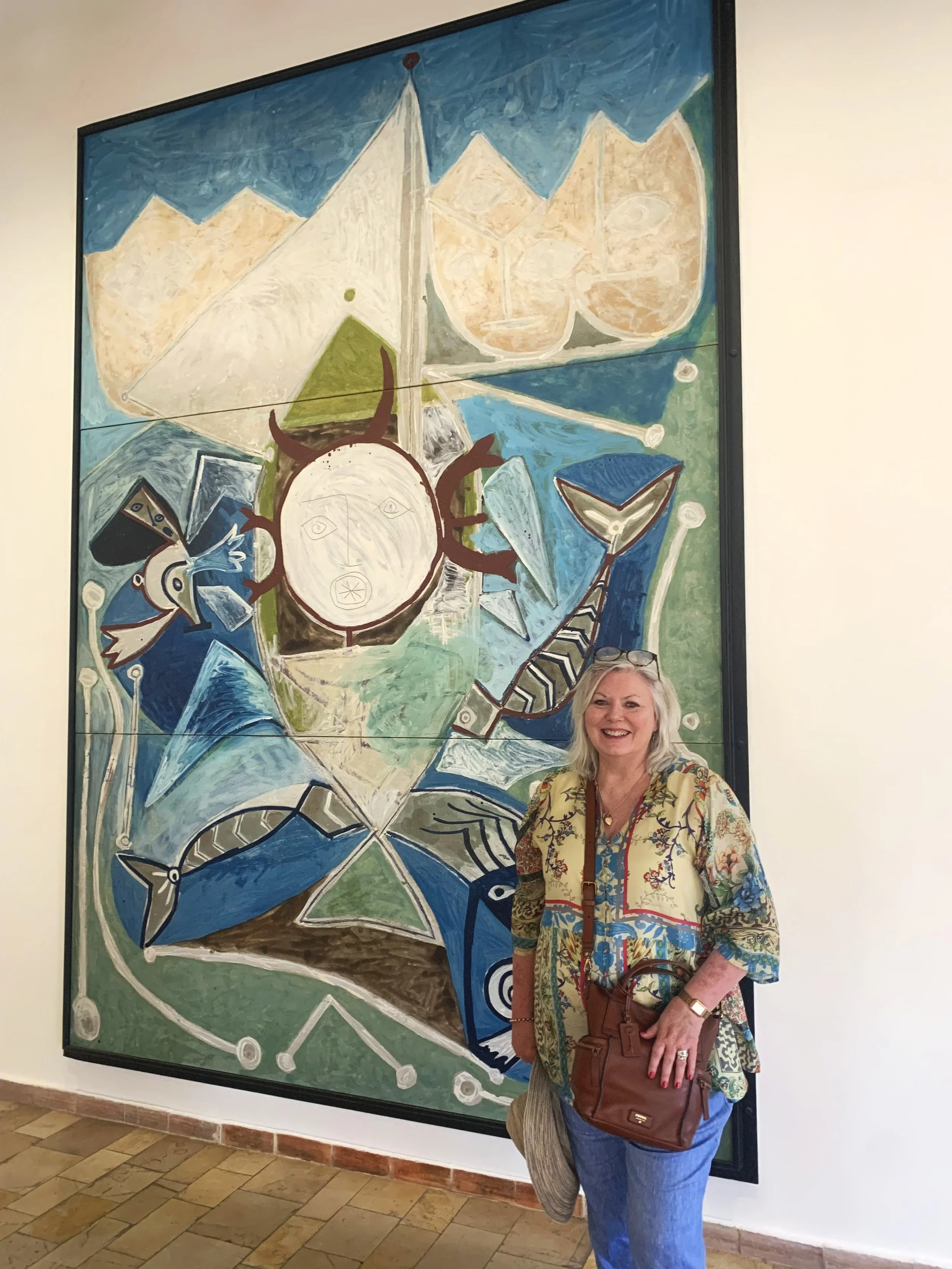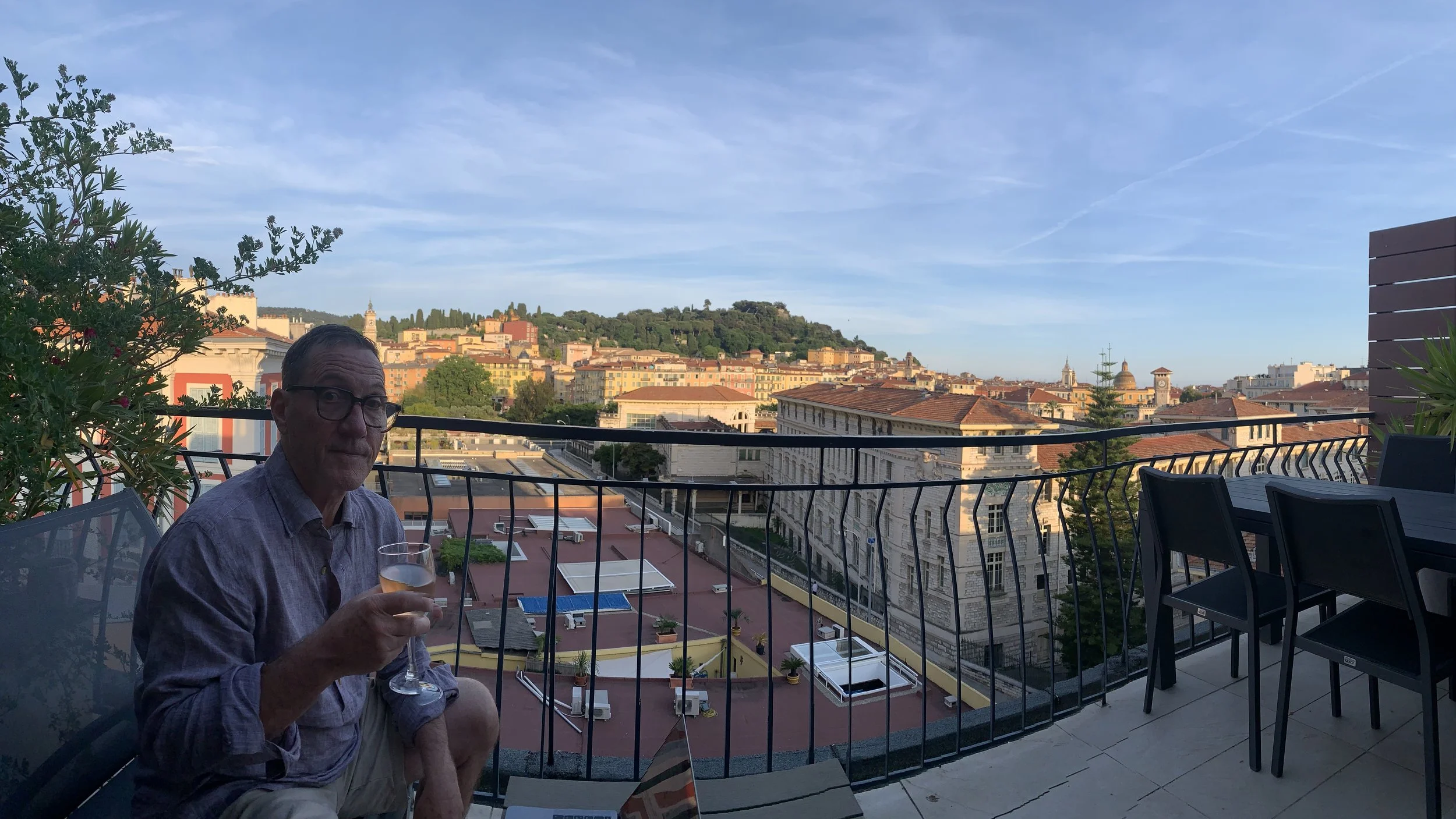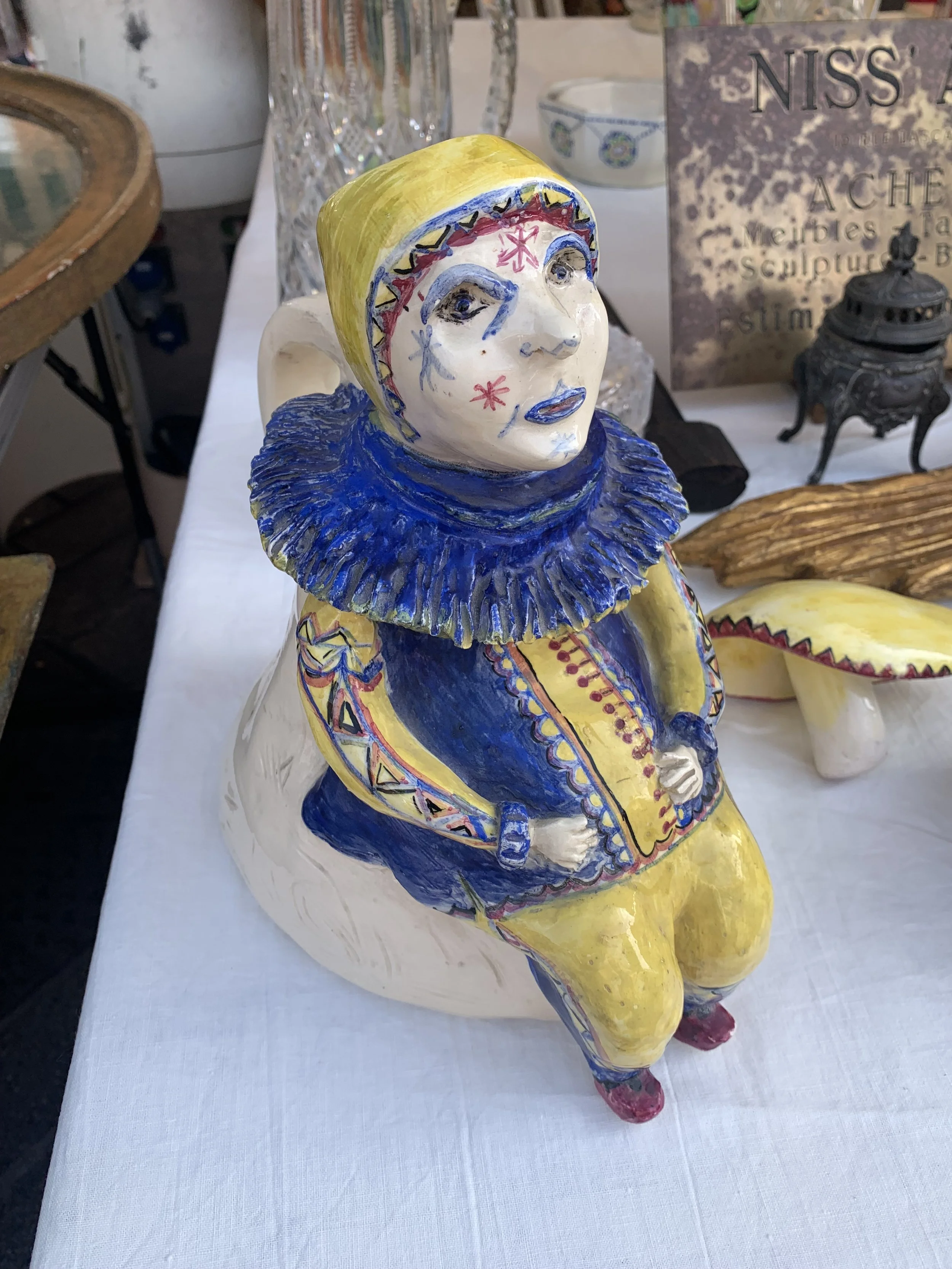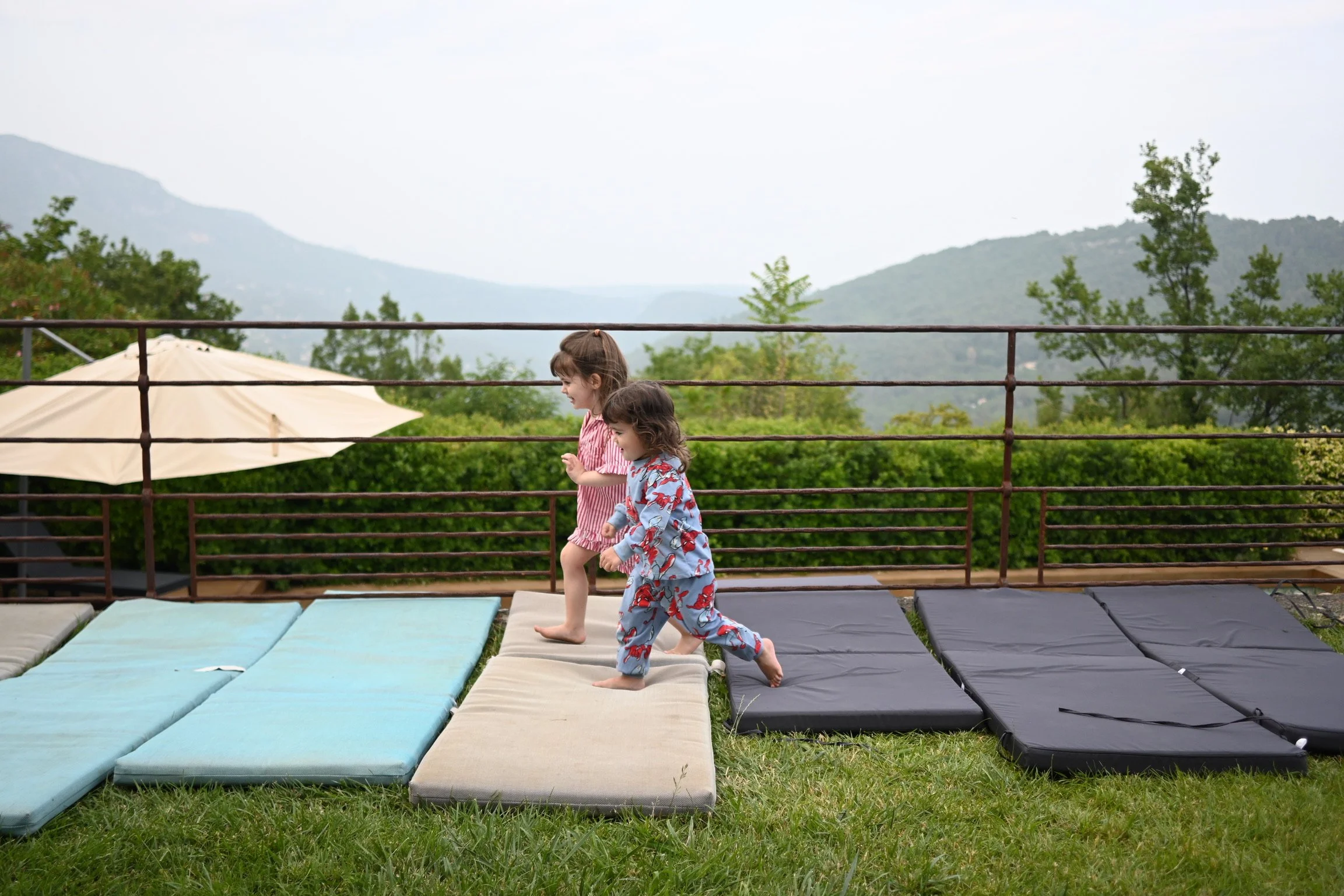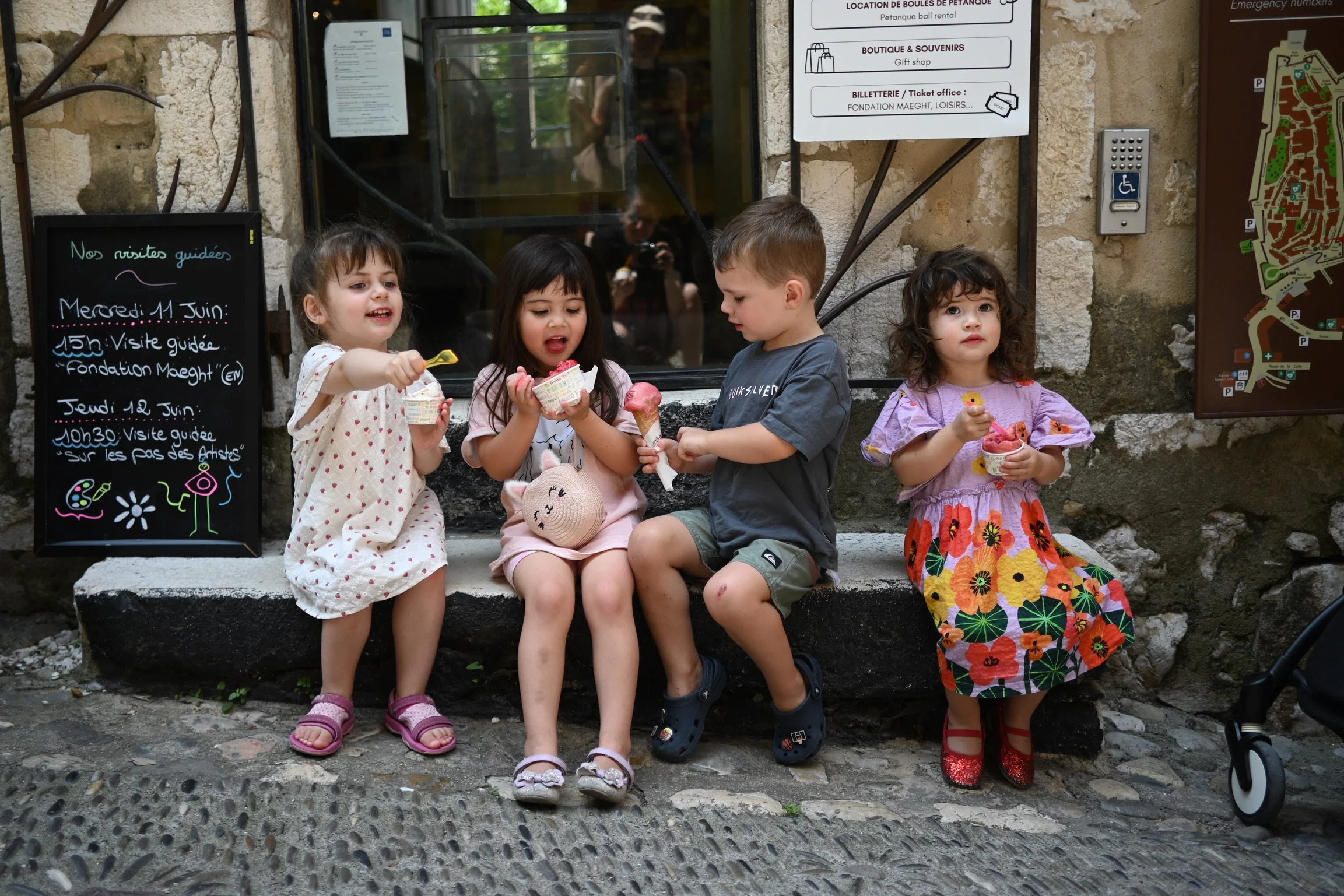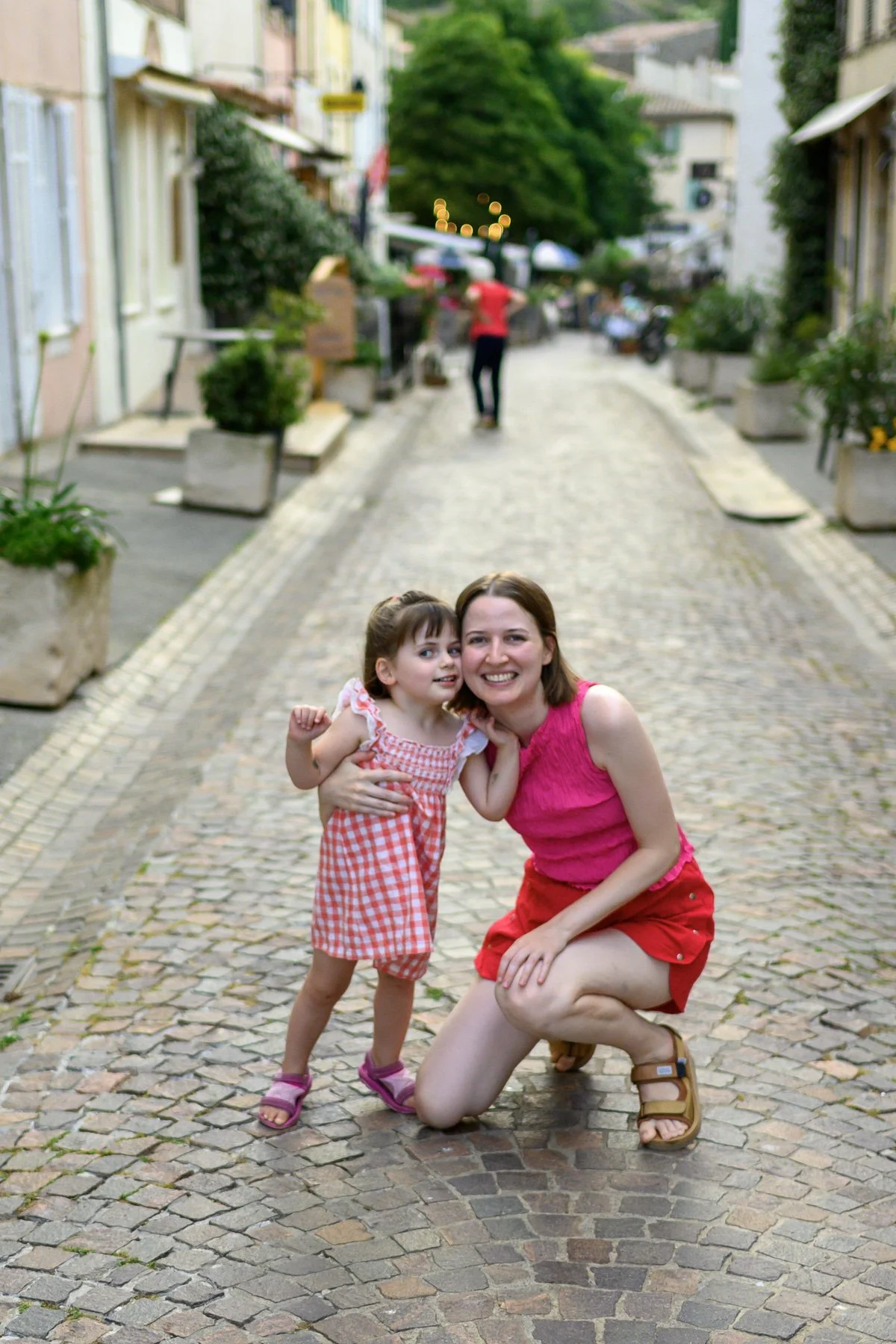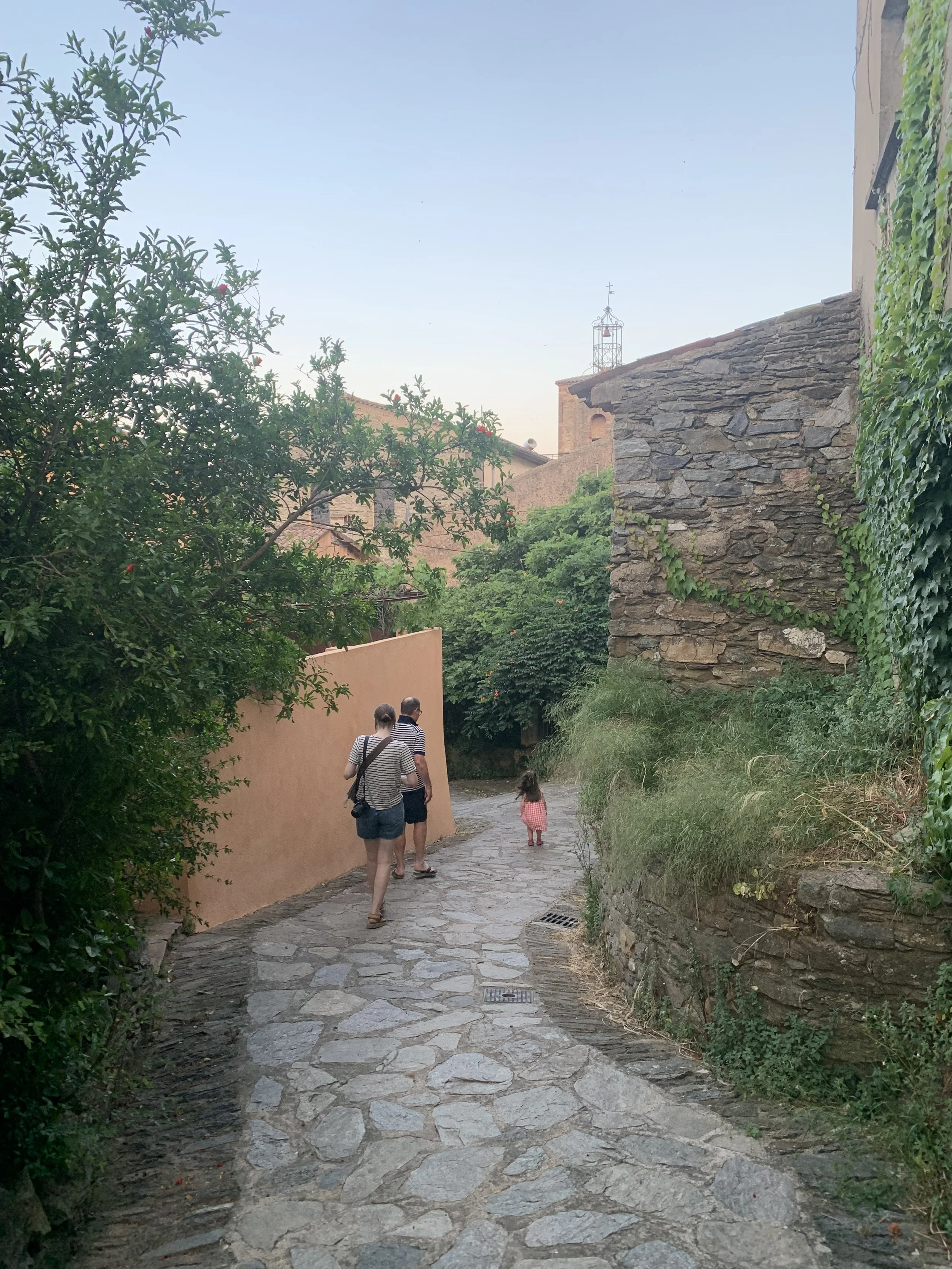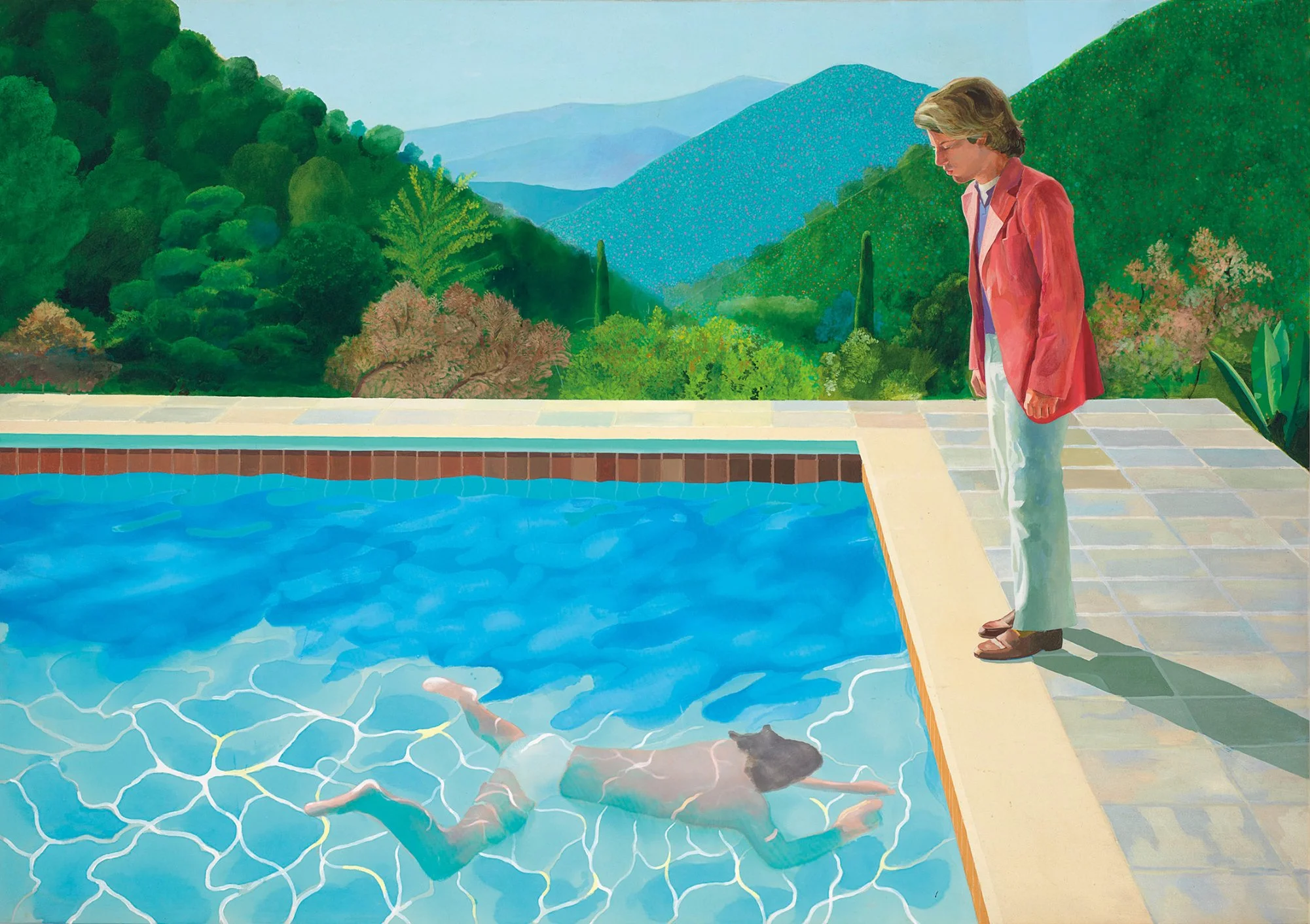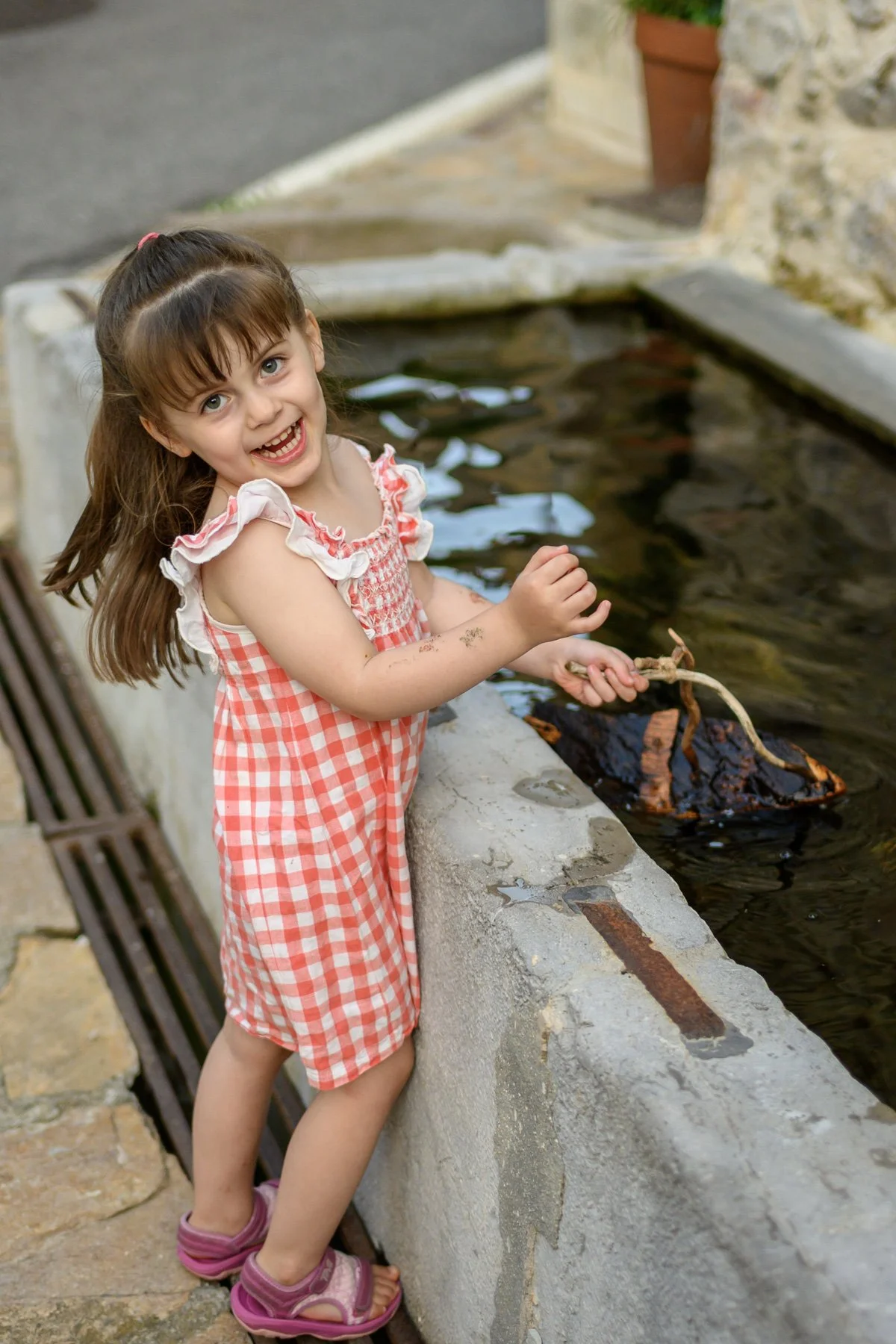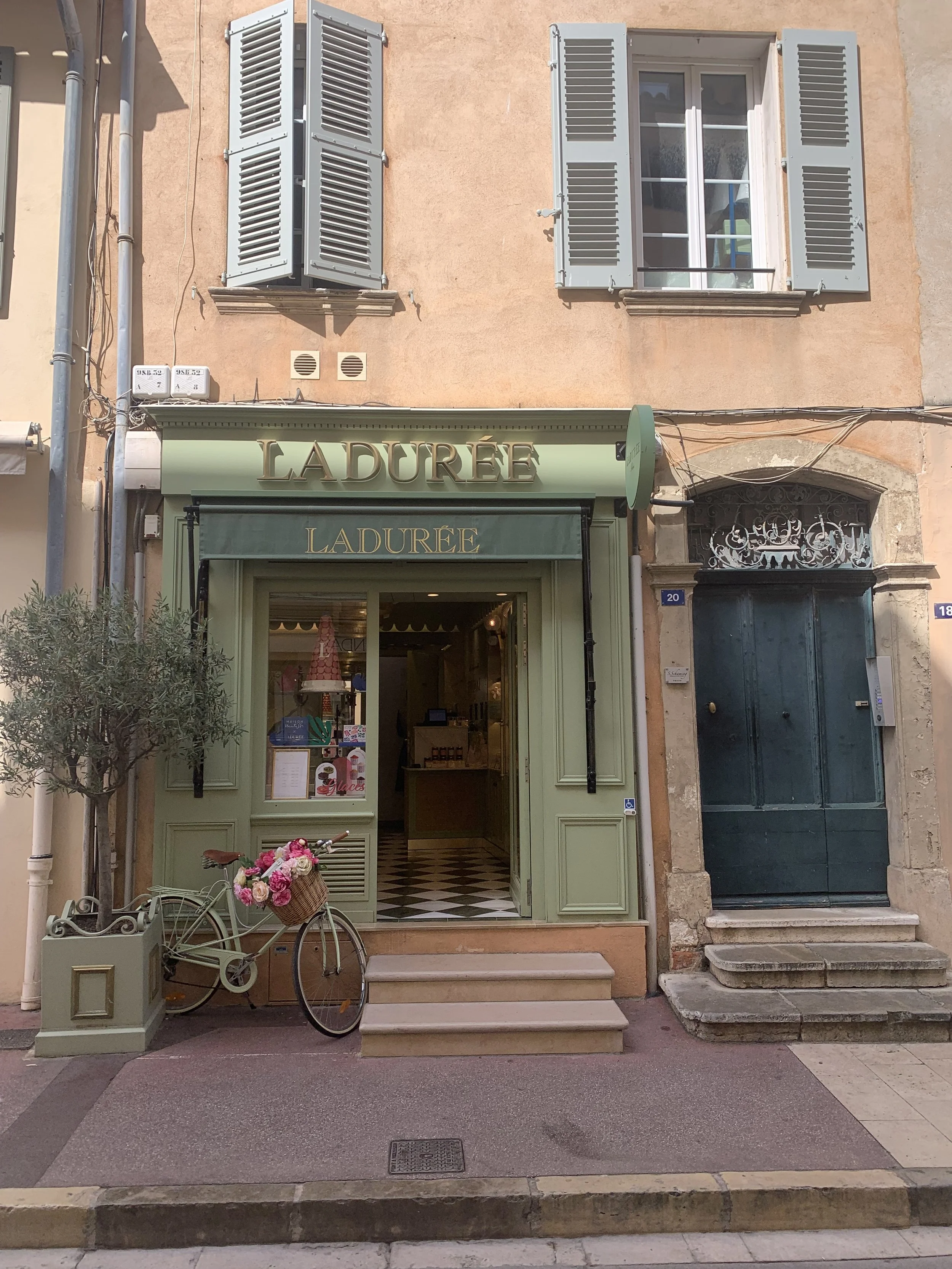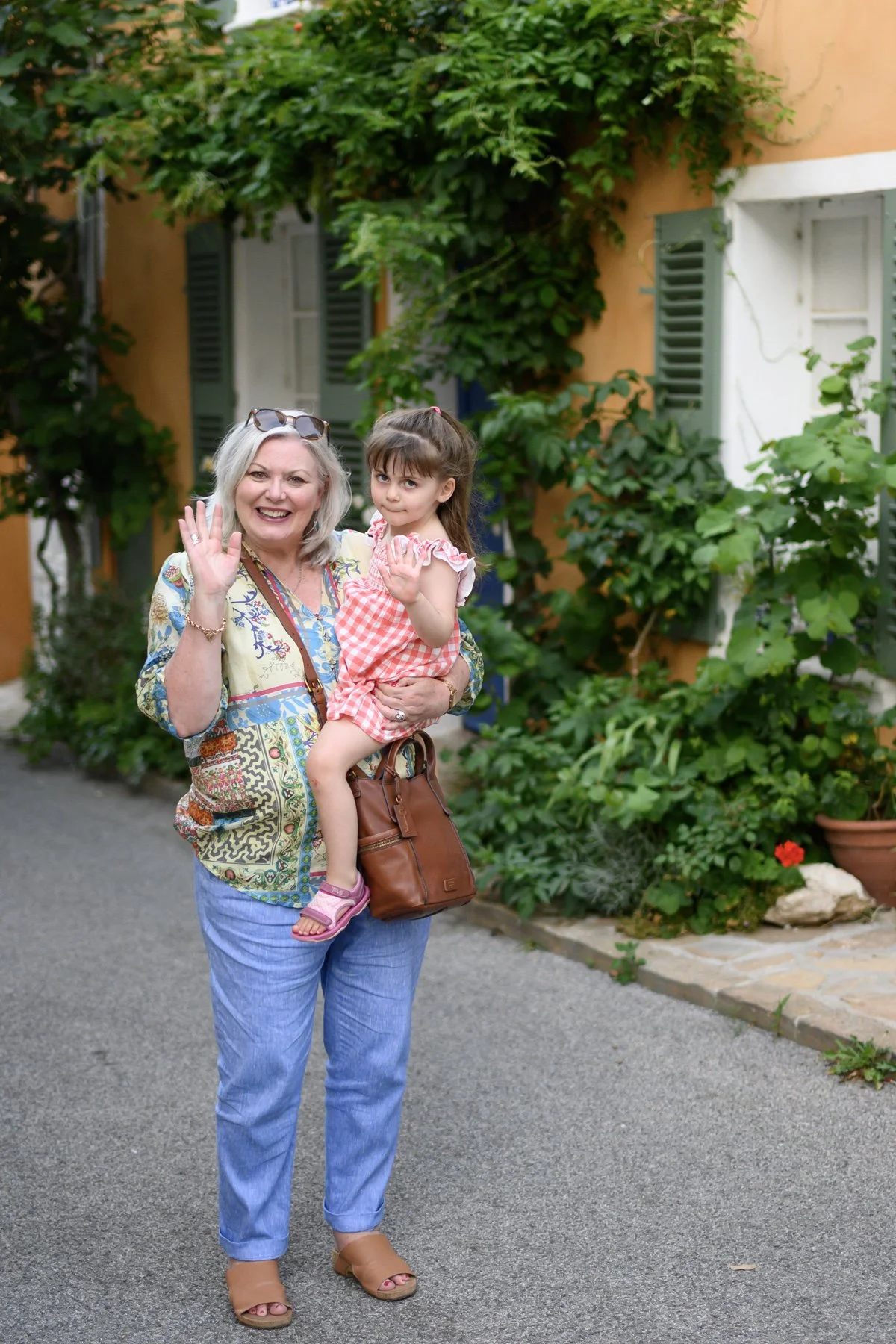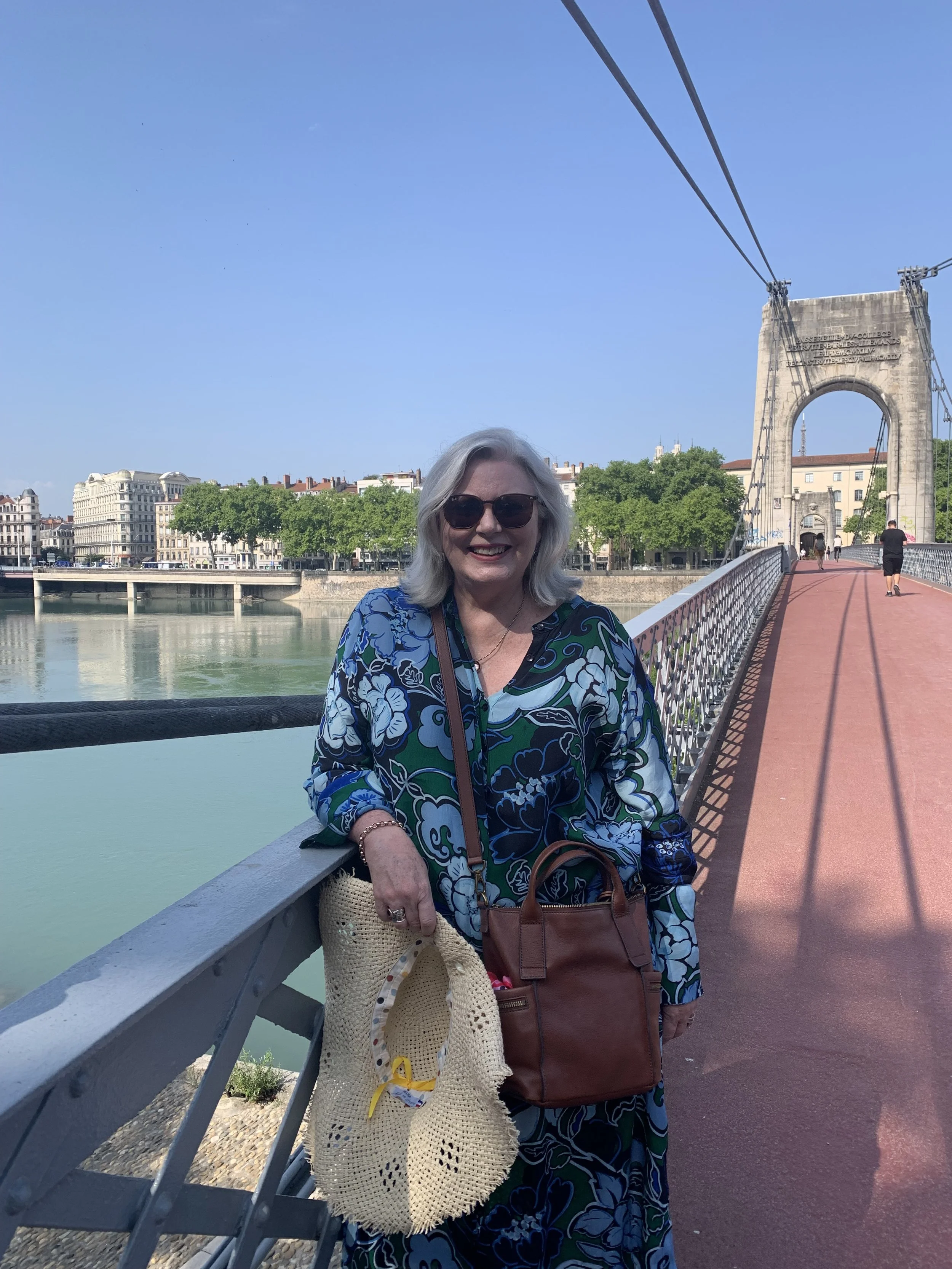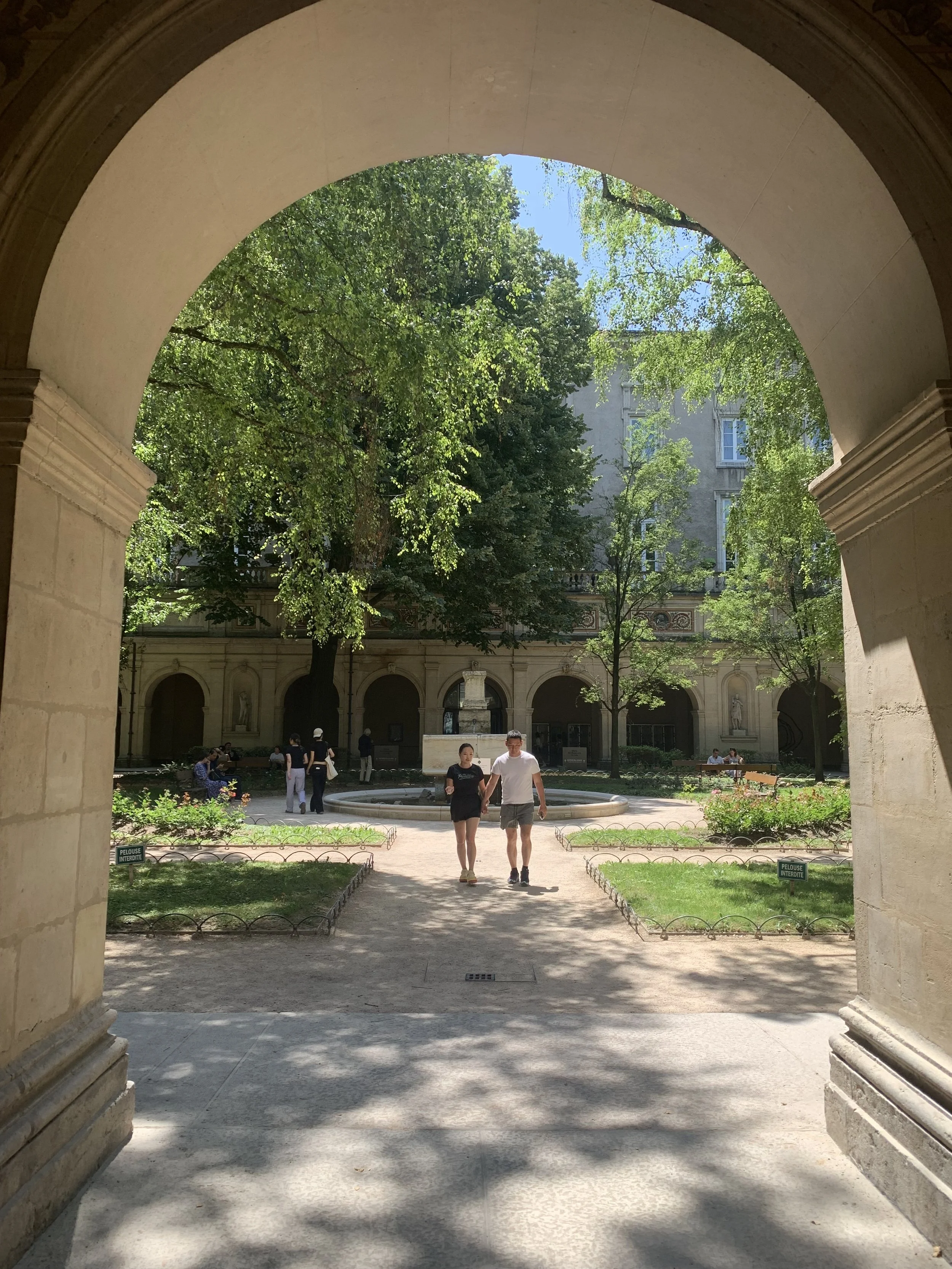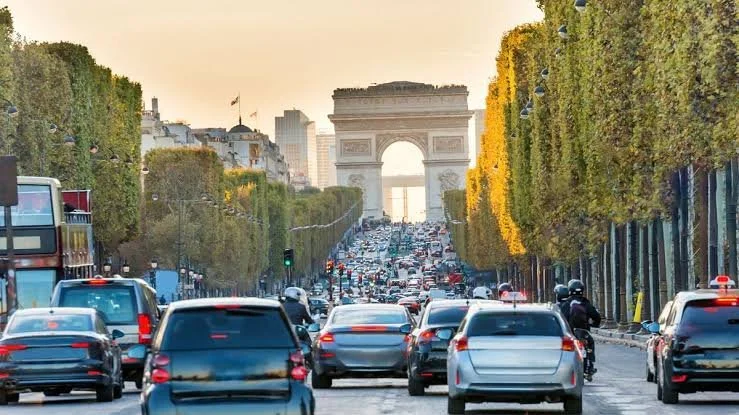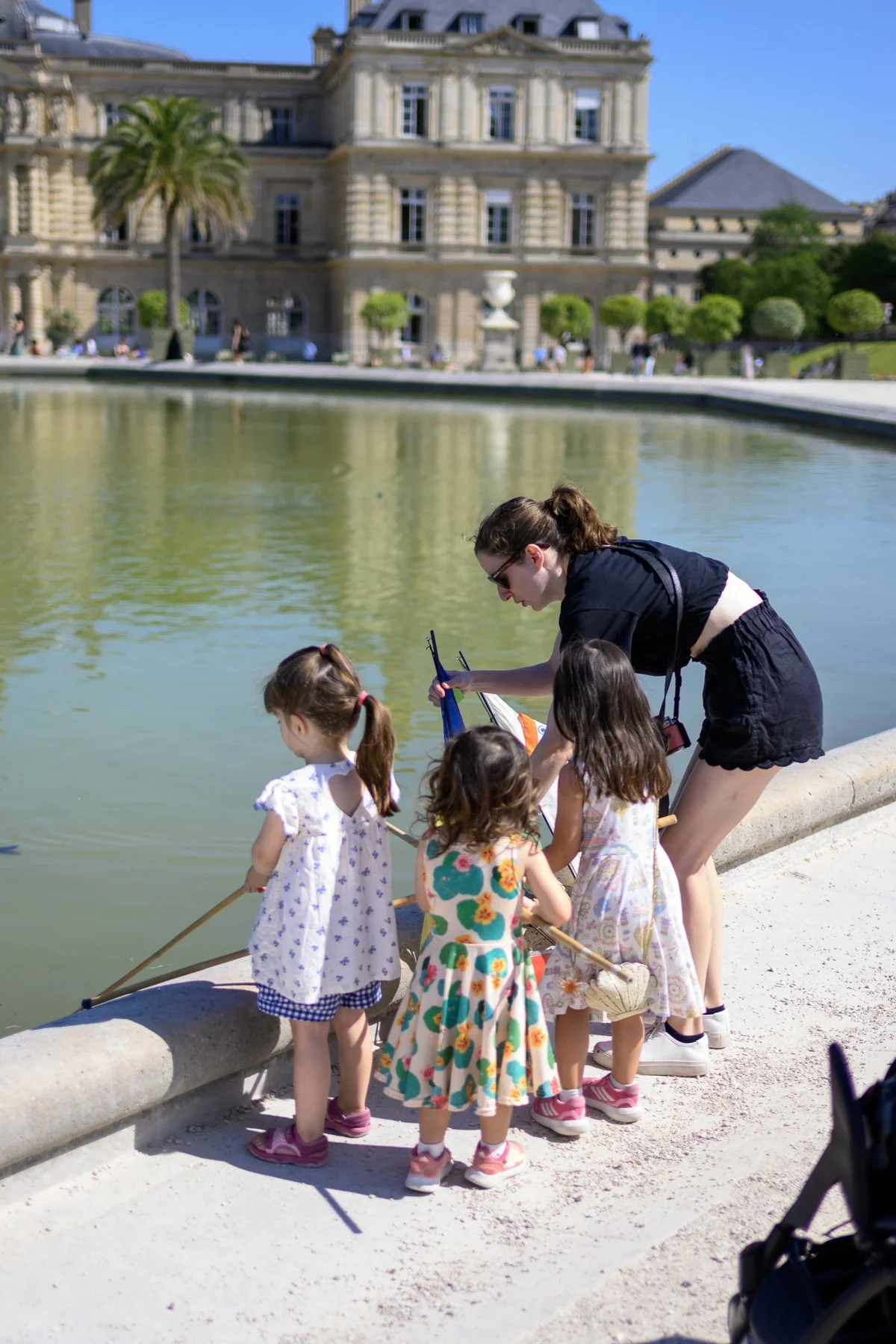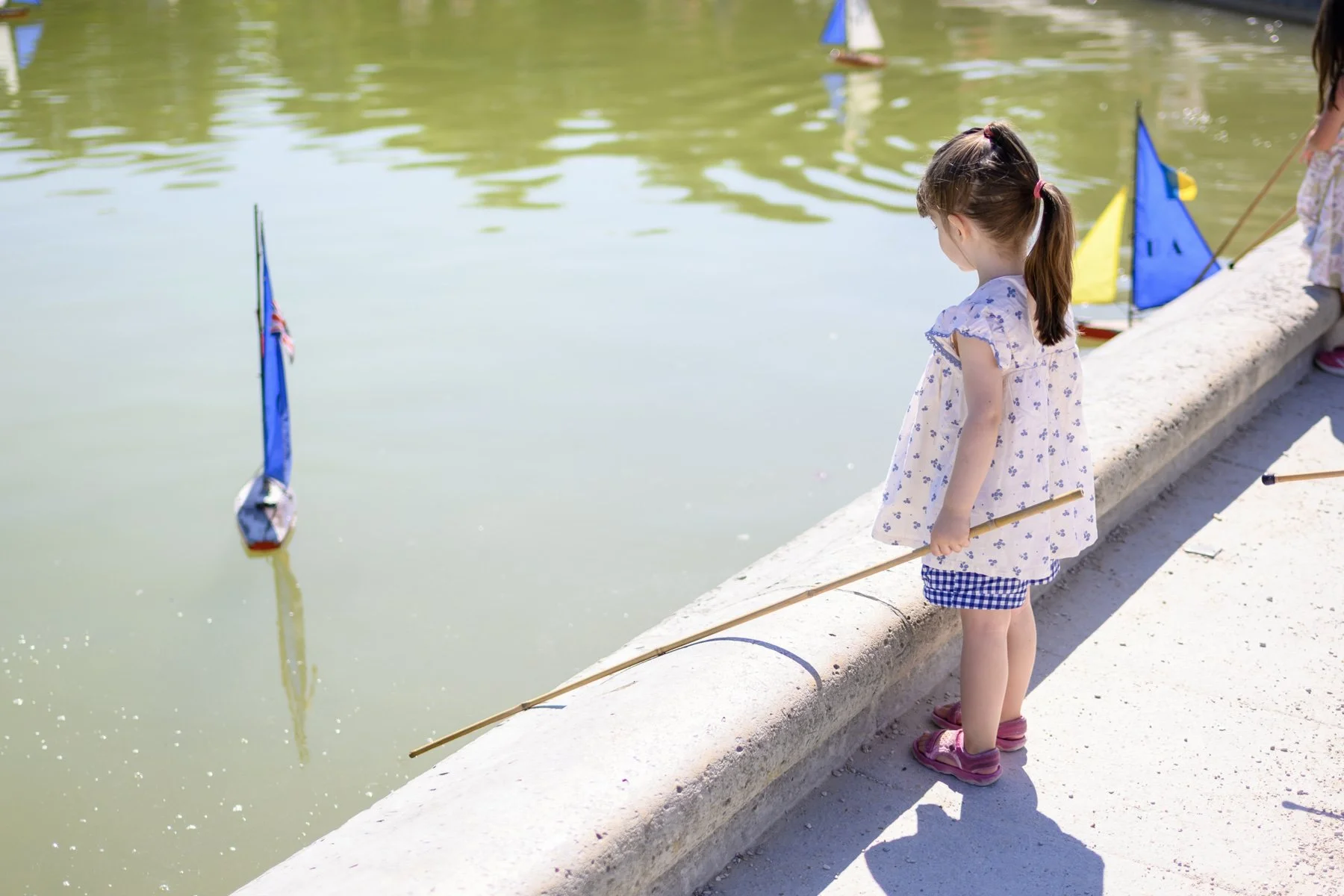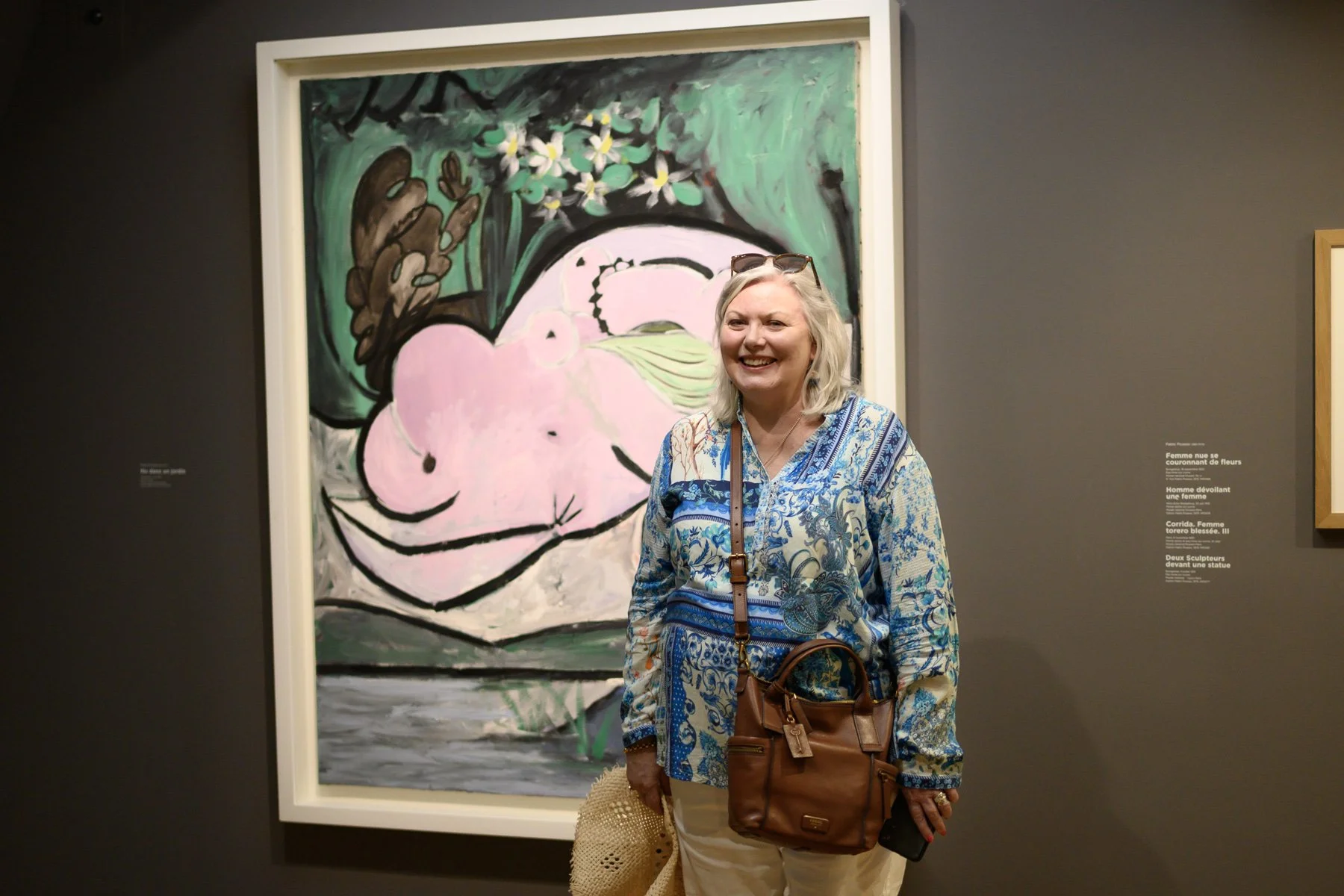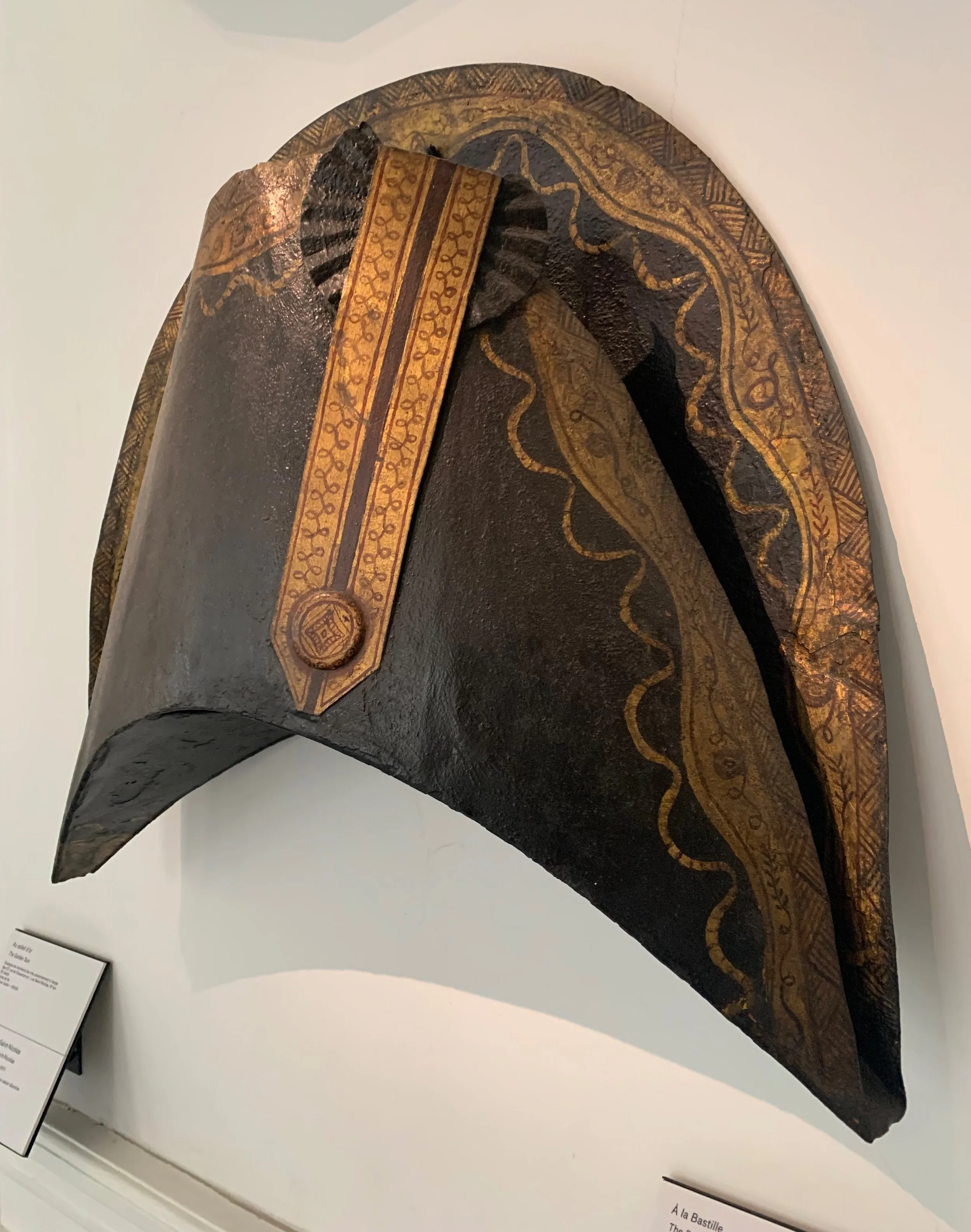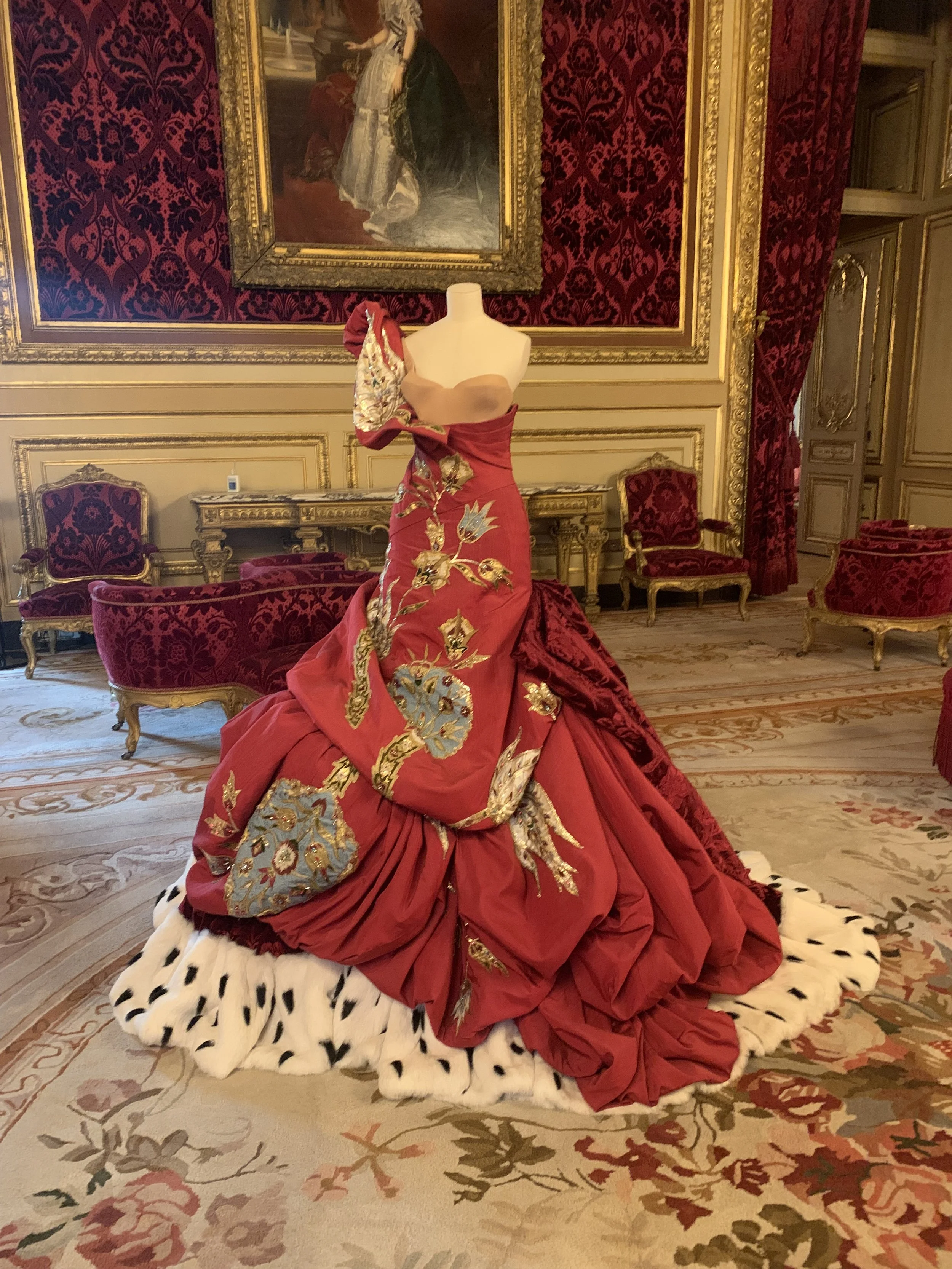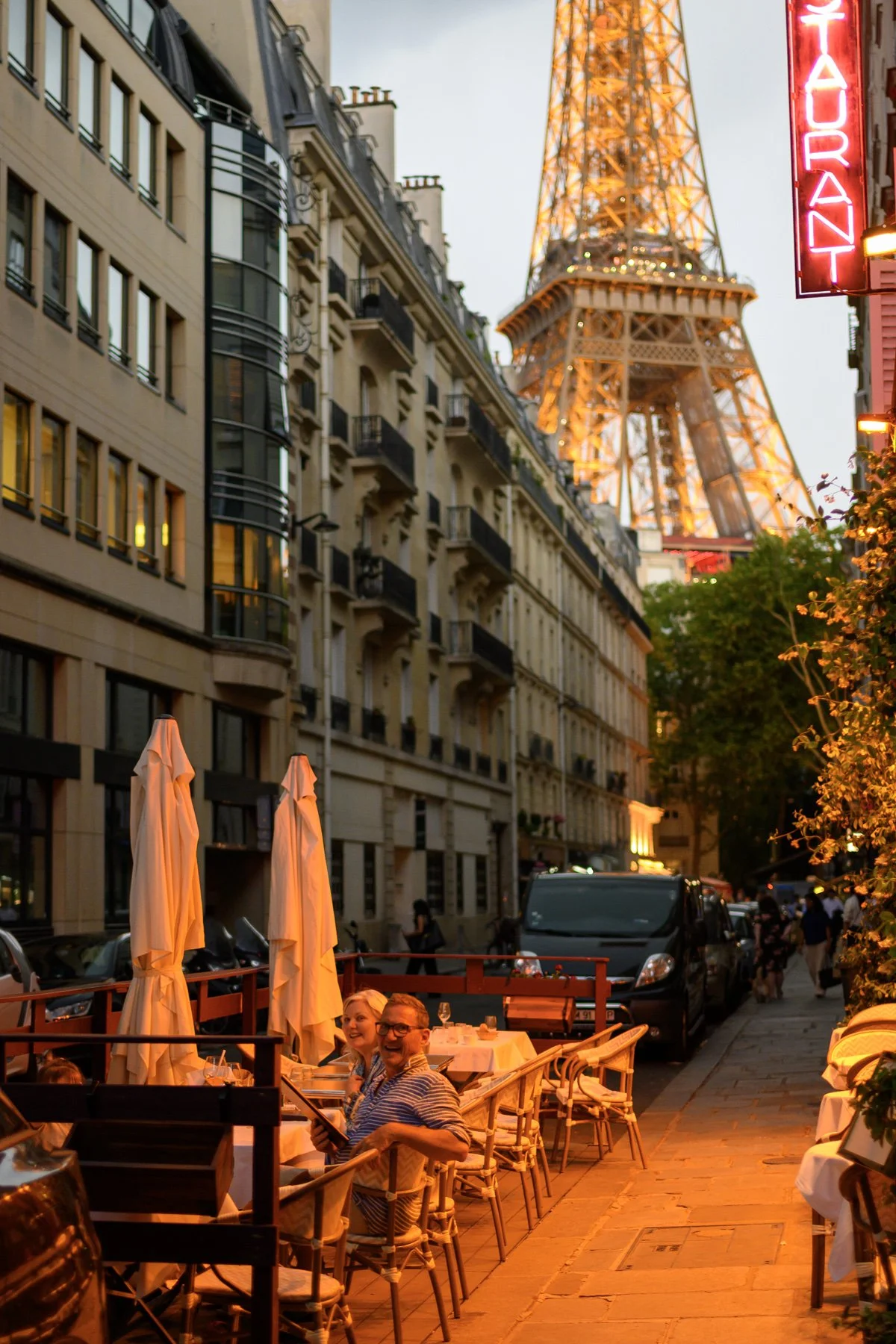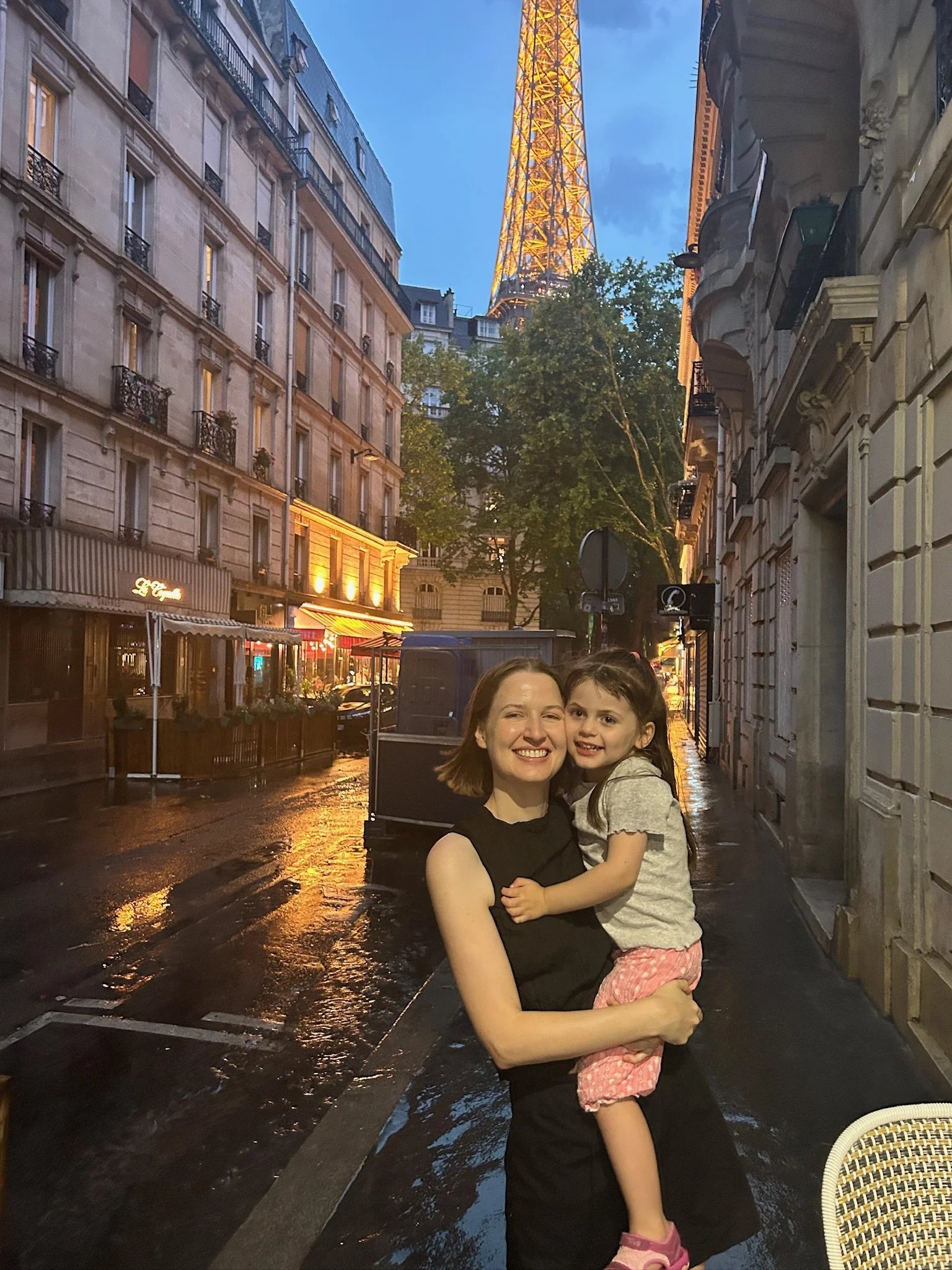JUNE STUDIO NEWS
In front of Picasso’s La Joie de Vivre (The Joy of Life) 1946, at the Picasso Museum, Antibes.
Bonjour from the South of France!
Hello friends—and yes, you’re reading that right. France again! Twice in one year (or twice in two newsletters, if you’re counting). A rare and wonderful occurrence indeed.
This time, I’ve traded the solo artist’s suitcase for something a little grander: a joyful, chaotic, heart-full family adventure to celebrate my husband’s special birthday. We've gathered our children and their little ones—cots, prams, bedtime toys, and dress-up costumes all in tow—for a big French celebration in a rambling house near Grasse, just outside of Nice.
The paintbrushes are packed away (for now), but rest assured I’ll be soaking up every golden shaft of Provençal light, every market basket brimming with lavender and cheese, every flourish of French style and culture. All to bring home with me, ready to infuse new works back in my Marrickville atelier.
I’ll be sharing little moments and stories from time to time—fragments of beauty, discovery, and inspiration—so I do hope you’ll follow along. Expect a weekly Instagram postcard from France, right there on your feed. Please follow me.
I'll be sharing weekly blog posts in my June newsletter, each one written from a different corner of France. If you'd like to join me for the first chapter—a vibrant week in sun-drenched Nice—you’ll wander with me through ochre-hued laneways, sun-warmed courtyards, and the quiet elegance of daily life on the Côte d’Azur. I spent unhurried mornings at the Cours Saleya markets, where the scent of fresh herbs mingled with sun-ripened tomatoes and just-baked socca. Long lunches brought Niçoise flavours to the table—salty olives, fragrant pissaladière, and chilled rosé.
Amid all this, we wandered through the city’s luminous art galleries: the joyful colour of the Musée Matisse, the delicate touch of Musee Marc Chagall, and the hushed beauty of the Musée des Beaux-Arts.
WEEK 1 - NICE & SURROUNDS
Andrew on our Nice Balcony, overlooking Old Town
When I travel, I’m not just looking for landmarks—I’m looking for how people live. We grow up with so many shared rhythms, yet the chapters of our lives can unfold so differently depending on where we’re planted. It’s that difference—those small, tender details of daily life—that I’m drawn to.
Take Nice. A city of just under 350,000, it has the scale of a coastal capital, yet the intimacy of a patchwork of hillside villages. In Vieux Nice, the old town, sunlight slants into narrow, winding lanes—stone underfoot, shutters overhead, every corner filled with the soft noise of life: laundry flapping, children laughing, the distant music of the sea. Town squares like Place Garibaldi or Place Masséna aren’t just for show—they’re communal living rooms where locals gather to talk, argue, laugh, and linger. The pace is gentle, yet busy. The days seem strung together by market mornings, shared meals, and rambling walks through warm, winding streets.
Artists have long been drawn to this light and this way of life. Matisse painted prolifically in Nice, especially from his rooms at the Hôtel Regina in the Cimiez district, where the Mediterranean light flooded the interiors and coloured his now-iconic cut-outs and serene interiors. Dufy too found his palette here—bright, free, and bursting with movement. Just up the hill, Chagall’s spiritual, dreamlike works found their home in the Musée Marc Chagall, though his inspiration came from the entire region, where his biblical themes danced against sunlit stone and sky.
And then, Antibes. A town that seems to tilt slightly into the sea—quieter, smaller, a little sleepier than its Riviera siblings, but with its own pulse. With around 70,000 residents, life here feels deeply rooted. The layout is honest and lived-in: winding cobbled lanes, tiered apartments with painted shutters, old stone walls thick with memory. I walked through the old town yesterday and imagined what it might be like to grow up here—in one of those modest, sunlit apartments overlooking the Mediterranean. There’s beauty, yes—but also a gentle regularity. Trips to the market. Familiar greetings in the square. Evenings marked by the angle of the light.
It’s here, in the Château Grimaldi—perched above the sea—that Picasso painted for a brief, explosive period in 1946. The former castle, now the Musée Picasso, still holds the brush marks of that season. You can feel his energy in the rawness of the walls, in the sunlight that pours through high arched windows, in the way the sea reflects back into the space. It’s not just a museum—it’s a moment held in place.
Both Nice and Antibes seem to ask you to slow down and see. To notice the rhythm of a lived-in day. The life behind the shutters. The familiar curve of an old staircase. The glow of light on a painted wall. And maybe, in witnessing these things, we see something not just about them—but about ourselves, too.
Chagall’s Adam and Eve, expelled from Paradise, 1961 - in the National Marc Chagall Museum.
We’ve decided to try and live like Nice locals, not tourists—and from this central spot, let our imagination guide us. Each day, we follow a thread: a flicker of interest, a whisper of history, a turn in the light. And while it’s impossible to share everything we’ve seen with any great depth, what I can offer are the surprises—the gentle upendings of expectation—and the places that linger.
Nearly thirty years ago, we visited both the Musée Matisse (Nice) and the Musée Picasso in Antibes. My memories of them were vivid and iconic—etched in my mind like the lines of a beloved drawing. Naturally, I returned wondering whether the Marc Chagall Museum in Nice would pale in comparison, quietly standing in the shadow of these two Riviera giants.
But it didn’t. Not for a moment.
The Musée National Marc Chagall, nestled into a hillside in Cimiez, revealed itself slowly—like Chagall’s own dreamlike imagery. It moved me deeply, in ways I hadn’t anticipated. There was something profoundly human in the way his work was presented: raw, spiritual, luminous. But what struck me most wasn’t just the visual experience—it was hearing Chagall speak about his work in an archival film. There he was, candid and searching, describing the pursuit of perfection with the honesty of someone who had spent a lifetime chasing it.
He once said, "If I create from the heart, nearly everything works; if from the head, almost nothing." And yet he was rigorous—hard on himself and hard on others. You could sense it in the brushstrokes, in the layering of paint and symbols, in the way he returned to the same themes again and again, seeking not repetition, but refinement.
The museum’s main gallery is a striking space—bathed in natural light and filled with Chagall’s monumental series The Biblical Message. Fourteen mural-sized canvases form a narrative arc, each one vibrating with colour, spirit, and mystery. Works including: The Creation of Man, Abraham and the Three Angels, and Moses Receiving the Ten Commandments aren’t just biblical references—they’re emotional landscapes, filled with longing, joy, sorrow, and transcendence. The vibrant blues alone seem to hum with something beyond pigment.
What also stayed with me—perhaps unexpectedly—was the group of young schoolchildren sitting cross-legged in the main hall, completely transfixed. Their guide telling stories, their teacher asked questions. They raised their hands eagerly. Some whispered excitedly to their classmates, others sat quietly, gazing upward. Their engagement reminded me that Chagall’s work, for all its spiritual depth and symbolic weight, but it also reminded me of how the French value art in every aspect of their lives, and it begins with their youngest, children get in free to all galleries and museums in France, and what’s not to love about that!
A Poiret Jug Vase at the Nice Flea Markets - I wish I’d bought it!
I often cringe—or at least raise an eyebrow—when I hear the phrase flea market. It carries that vaguely romantic but historically evasive promise: will it truly be a treasure trove of vintage finds, or just a jumble of chipped crockery and pseudo-Dalton figurines that never had value, and have even less now?
But the flea markets in Nice have disarmed all my cynicism. They are, without exaggeration, the finest I’ve ever encountered—brimming with quality and character, full of French je ne sais quoi. Stall after stall offers a kind of curated serendipity: hand-embroidered linens, weathered silverware, Art Deco mirrors, original oil paintings, and enough quirky charm to furnish an entire terrace in full Provençal splendour.
The term flea market—or marché aux puces—first appeared in 19th-century Paris, supposedly inspired by the idea that the second-hand goods for sale might be so well-loved (or neglected) that they were home to fleas. The earliest of these markets formed outside the city walls, made up of peddlers, collectors, and opportunists—selling everything from heirlooms to hopeful fakes. Over time, they became cultural landmarks, places where stories were traded as readily as objects.
In Nice, that legacy lives on—not in a dusty, forgotten way, but with real charm. Here, the past feels present, and each item has that delicious sense of having belonged to another life, another room, another moment in time.
And of course, there’s always that one piece you walk away from, only to think about endlessly later.
For me, it was a jug—yes, a jug—but no ordinary one. A sculptural, hand-painted figure in full theatrical regalia, perched like a miniature stage set. With its bold cobalt collar, yellow pantaloons, and red starburst cheeks, it felt like something plucked from a Poiret costume sketch or a Parisian marionette theatre. It was utterly bonkers and completely marvellous.
I hovered. I admired. I took a photo. And then I walked away.
And now, with the markets in Nice held only on Mondays, I’ll be well gone by the time this magical creature reappears—if it ever does. Should have, would have, could have. That’s the unofficial slogan of flea market wandering, isn’t it? But perhaps that's what keeps them enchanting—the idea that the most unexpected treasures are the ones you almost bring home.
Next week, I’ll be writing from the hilltop village of Bar-sur-Loup, just outside Grasse—where I’ll be trading sea breezes for mountain air, and sharing a week of stories, slow lunches, and family moments in the heart of Provence.
Nice Highlights:
Musée Matisse – Nice
Housed in a 17th-century villa in the Cimiez neighborhood, this museum showcases one of the world's largest collections of Henri Matisse's works, tracing his artistic evolution.
musee-matisse-nice.org
Musée National Marc Chagall – Nice
Dedicated to Marc Chagall's biblical-themed artworks, this museum features 17 large-scale paintings illustrating the first two books of the Old Testament.
musees-nationaux-alpesmaritimes.fr
Musée Picasso – Antibes
Located in the historic Château Grimaldi, this museum was the first dedicated to Pablo Picasso, housing a significant collection of his works created during his stay in Antibes.
Cours Saleya Markets – Nice
Situated in the heart of Nice's Old Town, Cours Saleya hosts vibrant markets:
Flower and Food Market: Tuesday to Sunday, offering fresh produce and local delicacies.
Antiques/Flea Market: Every Monday, featuring a variety of vintage items, from furniture to art pieces.
explorenicecotedazur.comthegoodlifefrance.com+5explorenicecotedazur.com+5lonelyplanet.com+5
WEEK 2 - FAMILY TIME IN LE BAR SUR-LOUP
Penelope, Zander, Zephyrine and Clementine - our castle for a week in Le Bar Sur-Loup near Grasse
Living slowly, celebrating richly, and letting the hills of Provence hold us together.
If Week One was all shimmering coastlines and the laneways of Nice, Week Two has unfolded like a sun-drenched family portrait—layered, lively, and full of heart. This is the week that sparked the whole trip. A secret promise made almost a year ago between daughters and their mother to celebrate their father’s (Andrew’s) 70th—early, yes (his birthday is in November), but far better to gather in the golden warmth of the South of France than in the greys of a Northern Hemisphere winter.
And somehow, from opposite ends of the world, we’ve done it. Three daughters, partners, and grandchildren—travelling by plane, rental car, and hopeful spirit—have all converged on a beautiful stone villa just outside Le Bar-sur-Loup, a perched village nestled between Grasse and the Alps. Our stone house is generous, sun-baked and soulful. Shutters swing open to reveal a view that stuns—steep green hills dotted with terracotta rooftops give way to the high, jagged folds of the Alpes-Maritimes. Our garden tiers downward—from the top, wild rosemary, daisies, and established olive trees; below, a mosaic-lined pool that invites us all to jump in.
Anastasia, Evangeline and Claudia in St. Paul de Vence
Mornings begin slowly. Andrew walks to the village via a bush track for croissants and baguettes. Coffee cups clink. Children’s feet patter across cool tiles. Each day holds no particular plan—sometimes we explore nearby towns like Saint-Paul-de-Vence or Grasse, depending on the energy of the children. Other days are all about the pool: blowing bubbles, playing Red Light Green Light (or Un, deux, trois, soleil), and inventing wild pretend picnics in the shade. There are prizes for the best pool jumps and endless rounds of made-up songs and storytelling.
Junior pool pillow olympics, Penelope and Zephyrine
Andrew and I have found ourselves slipping back in time—to a special place we knew before. Nearly thirty years ago, in a village called La Garde-Freinet just above St. Tropez, we played similar games with our baby girls, under a different fig tree but the same summer sun. Life folds back on itself in the gentlest of ways—echoes of a special past holiday now seen through the lens of another generation. And in that repetition, there’s something quietly profound. The years have passed, but this experience has connected us back through time, where we can see our now grown-up daughters as youngsters through the visage of their own children.
Mouth watering glaces in St. Paul de Vence, Penelope, Clementine, Zander and Zephyrine
This week’s focus has been on family—on moving slowly, listening to little voices, and not pushing children too far in the summer heat. We’ve been touring at children’s pace: taking breaks, seeking out shade, finding benches to rest and recoup. Of course, that means we don’t see everything. And I’m absolutely fine with that. I’d rather soak up the joy of this little crew than tick off every gallery in the region. I may have missed the Mirós this week, but I’ve gained sticky hugs, bubble-blowing contests, and the delight of watching cousins giggle under a gaggle of sun hats.
That said, there were two places I really wanted to visit before leaving Grasse. I’ve been to this town once before, and who knows if I’ll make it again—so we carved out a quiet afternoon to see both.
First: the Musée du Costume Provençal. Housed in the elegant Hôtel de Clapiers-Cabris, an 18th-century noble mansion, this museum is devoted to preserving the rich clothing traditions of Provence. Given my previous life in costume design, I’ve long been drawn to costume museums wherever I travel—and this one was too compelling to resist.
Inside, it's a treasure trove of silk bodices, lace-trimmed fichus, embroidered corsets, and delicate jewellery—garments once worn by Provençal women in the 18th and 19th centuries. Each ensemble seems to murmur its own quiet story. Lingering at the glass cases, imagining these women stepping over the same cobbled streets, brushing their hands through lavender or disappearing into the cool hush of a chapel. The craftsmanship is exquisite and deeply moving in its authenticity.
Entrance into the Musée du Costume Provençal
Then, just a short walk away, the Musée International de la Parfumerie. As the world’s perfume capital, Grasse has long deserved a space like this: immersive, poetic, and intelligent. The museum traces the 3,000-year-old history of scent, from ancient Egypt to Chanel No.5. There are antique stills, rare botanical specimens, and scent stations where you can breathe in the past—literally. I loved the layout: elegant, modern, with terraces of perfume plants outside and vaulted exhibition rooms inside. It made me think about how we carry memory in smell. I caught a whiff of jasmine and was suddenly six years old in my grandmother’s garden.
Some of the standout things for me: the tiny perfume bottles shaped like birds and fans, the bold art deco advertisements, the deep violet flacon designed by Lalique. And the rose oil press—functional, beautiful, and so rooted in the land. Grasse blooms in that building. You don’t just learn about perfume—you feel its history in your bones.
One of the many themed parfum vessels on display at the Musée International de la Parfumerie, Grasse
Andrew with our youngest traveller - Baby Hunter
Zephyrine and Clementine, water trough mermaids, Valbonne Town Square
And on our last day together, I find myself hopeful. Hopeful that, despite their tender age, our young grandchildren might carry away snippets of this special week. That they’ll remember paddling their feet in the cool horse trough in Valbonne, the freedom to run through sun-dappled town squares where restaurant patrons only ever responded with smiles, and the joy of waking each morning to the familiar, welcoming company of their little cousins.
What I do know is this: their parents will remember—just as we have, for the past thirty years.
Clementine and Penny light up Valbonne Square
Penultimate night in Le Bar Sur-Loup - What’s not to love about France!
Next week, I’ll be writing from La Garde-Freinet, our townhouse nestled in the heart of the village. Penelope and Claudia will be joining us there, and with them, a new rhythm—fresh conversations, familiar hills, and more stories waiting to unfold.
Le Bar Sur-Loup Highlights
Musée Fragonard – Grasse
One of the oldest perfume factories in Grasse, Fragonard offers a delightful museum experience with antique distilling equipment, perfume bottles, and olfactory curiosities. Free guided tours available.
usines-parfum.fragonard.com
Musée International de la Parfumerie – Grasse
A world-class museum exploring the history of fragrance through interactive exhibits, rare plants, and terraced gardens.
museesdegrasse.com
Musée du Costume Provençal – Grasse
This hidden gem showcases exquisite 18th–19th-century Provençal costumes and jewellery inside a historic mansion—a charming insight into traditional regional dress.
provence-alpes-cotedazur.com
Saint-Paul-de-Vence
A medieval hilltop village beloved by artists and poets. Wander cobbled lanes, visit art galleries, and pay homage at Marc Chagall’s grave. Full of galleries, boutiques, and Provençal magic.
theemptynestexplorers.com
Valbonne Village
A tranquil 16th-century village laid out in an Italian-style grid, rare in Provence. Expect charming pastel buildings, lively town squares, and relaxed cafés under shady arcades.
tripadvisor.com
Le Bar-sur-Loup Village
A lesser-known medieval gem perched above the Loup valley. Quiet stone lanes, views over citrus orchards, a 13th-century castle ruin, and a famously delicious orange wine awaits.
france-this-way.com
Week 3 - La Garde-Freinet On memory, return, and the shimmer of places we hold dear
Penelope and Claudia in the restaurant strip of La Guarde Freinet
Should you ever try to repeat a favourite holiday? Can it match—or even surpass—the version your memory has so lovingly gilded? It’s a gamble. You risk not just disappointment, but dulling the edges of a once-in-a-lifetime moment. And yet, here we are. I’ve broken my own rule and booked us a week in La Garde-Freinet—a perched village about 30 minutes above Saint-Tropez, nestled in the Massif des Maures. Almost thirty years ago, Andrew and I brought our three little girls here, invited by dear friends to stay with them and their own young children for a month of pure Provençal enchantment.
Heading towards Église Saint-Clément church, dedicated to Pope Saint Clement, dating back to 1571 .
Back then, we stayed at Si Nid du Duc (The Owl’s Nest)—a gentle slope of restored medieval stone cottages, wrapped in vines and wisteria, filled with French furniture, owl motifs in paintings and ceramics, and children’s drawings taped to the walls. Peacocks cooed and roamed freely. A glittering pool looked out over forested hills. It wasn’t just a house; it was a feeling. A portal into another way of living—carefree, creative, and deeply connected. Its history only added to the dreamlike quality. The home had been purchased by Tony Richardson, the Oscar-winning British director and in the 1960s and '70s, it became a discreet haven for his circle—and when we knew it, a treasured family escape for Vanessa Redgrave, her daughters Natasha and Joely Richardson, their extended family and friends. It’s widely reported that David Hockney painted Portrait of an Artist (Pool with Two Figures) here—its still blue pool and emotionally charged figures echoing the quiet tension of this place. One figure submerged, the other poised on the edge—two souls impossibly close, impossibly far. That’s how memory can work, too - one version underwater - another reaching from the shore.
David Hockney’s Portrait of an Artist (Pool with Two Figures) One of the 20th century’s most widely recognised paintings, Portrait of an Artist (Pool with Two Figures) realised $90.3 million in November 2018, placing it among the most expensive works by a living artist ever sold at auction - and more expensive than the village of houses it was painted in.
This time, however, we’re not staying at Si Nid, but in a charming townhouse in the heart of La Garde-Freinet. Since Le Bar Sur-loup - Anastasia & family have continued on to Paris, Evangeline & family have flown home. Penelope and Claudia joined us for the first few days, and together, we retraced our steps through cork forests and summer wildflowers, following that secret, single-track road in search of the place we’ve long held on a pedestal. And we found it. Like quiet sleuths—with a little help from Google Maps—we discovered the unmarked turn-off and crept along every familiar bump of the track. And there it stood, just as regally as before. I scanned the rooftops, remembering who slept where. The large stone kitchen bustling with shared meals. The laughter and dancing on the terrace, holding our toddlers and children in our arms. As my eyes rested on that house and I knew it was time to leave again, it felt like embracing a shadow from the past—never vanished, only folded gently away, kept safe until the moment I was ready to welcome it home, before packing it away once more.
Main house of Si Nid du Duc and pool, more stone houses above and behind pines
Turning from memory to the present, we’ve found joy again in the village itself. It’s become buzzier since our last visit—more restaurants, more visitors soaking in the relaxed atmosphere—but the charm remains intact. Market days still bring the square to life on Saturdays and Wednesdays. Boules is played in the evening light as the heat eases. The 16th-century church still stands solid at the heart of the village, its bell marking each hour (yes even at 3am). And the 19th-century stone water trough continues to overflow with cool spring water—this time with a magical little surprise: two handcrafted boats made from twigs and cork, waiting for children to send them drifting. Penny was in heaven.
The joy of finding a cork boat left by a generous local - village life, what’s not to love!
There are three roads that lead between La Garde-Freinet and Saint-Tropez. Or perhaps it's better said: there are three ways to descend from this quiet hilltop village to one of the most famous and coveted seaside towns in the world. Each route is stunning—winding through cork oak forests, steep switchbacks, and postcard-perfect glimpses of the Riviera below.
And while Saint-Tropez is undeniably beautiful—its ochre walls, glinting harbour, and medieval foreshore—it feels, to me, just a little too polished now. The renovations have been incredibly respectful to the bones of the town, and there’s still something real in its daily markets and antique stalls. But it probably sat outside my comfort zone even thirty years ago.
These days, the village is dressed in designer. The boutiques gleam like curated art galleries—think Milan shopfronts reimagined for the seaside. I happily wander, admiring the windows as if they were paintings, but I’d rather be in a place where the average Florian or Véronique might actually live and work.
So, I’m content to be a visiteuse for the day. But I wouldn’t stay in Saint-Tropez.
Not a pebble or a twig on the streets of St. Tropez
With Penny, wandering through the local streets after dinner in La Guarde Freinet.
La Garde-Freinet, with its soft hills and lived-in rhythm, still feels like a place where life unfolds quietly and without pretence. And for us, this return has been not about reliving the past, but gently walking alongside it—with gratitude.
Some places live inside us forever. And if we’re lucky, we get to walk their streets again—with a little more grace, and a deeper understanding of what they meant all along. Thank you La Guarde Freinet!
Next week, I’ll be writing as we travel to Paris via Lyon—the final flourish in our four-week adventure.
La Guarde Freinet Highlights
Saint‑Tropez
A sun-drenched port where fishing boats meet megayachts. Glamour, charm, and Mediterranean light.
👉 Visit Saint‑Tropez
Bormes‑les‑Mimosas
A floral hillside village known for its mimosa blooms and pastel lanes. Timeless and fragrant.
👉 Explore Bormes‑les‑Mimosas
Grimaud
Medieval stone, a hilltop château, and sweeping views of the Gulf. Still, golden, and full of history.
👉 Discover Grimaud
Aix-en-Provence – Bouches-du-Rhône
A city of fountains, faded shutters, and sunlit charm. Once the Roman capital of Provence, Aix is where Cézanne’s light still lingers. Stroll markets, sip rosé, and feel time slow.
👉 Discover Aix-en-Provence
Moustiers‑Sainte‑Marie
Cliff-hugging beauty, faïence pottery, and a tiny chapel under the stars. Pure magic.
👉 Explore Moustiers
Standing on the Passerelle Saint-Georges pedestrian bridge that takes you to Old Town Lyon
WEEK 4 - TO LYON & PARIS - OUR FINAL FRENCH FLOURISH
Feeling a little melancholy to say goodbye to the parasol and pencil pines that have so beautifully punctuated our journey through the South of France. This was the final flourish of our four-week fabulous France adventure.
Now it’s just Andrew and me, heading north—stopping shortly in Lyon and bound for Paris—along roads flanked by cathedrals of plane trees arching above us. The scenery has shifted. Gone are the medieval villages perchés with their soft terracotta tiles and sun-warmed stone. In their place rise grander entrances to northern towns, with slate-clad toits en ardoise—steeper, sharper rooflines, built for snow and storm, not sun and siesta.
We’re looking forward to joining Claudia and Anastasia and their families again in Paris.
The landscape now rolls in gentle swells of wheat, corn, and colza (rapeseed), and the villages feel hushed, a little more stoic in their posture.
As the French writer Christian Signol once said:
"Chaque village a son âme, mais aucune ne se ressemble."
(Every village has its soul, but no two are alike.)
Les Halles de Lyon Paul Bocuse - a mouth watering reason to change citizenship
Lyon, where we paused for two days, is remarkably walkable—and far grander than I had imagined. Monumental spaces like Place Bellecour, Place des Terreaux, and the Hôtel de Ville make you feel as though you’ve stepped into a stately urban opera. It’s no wonder the city has a world-class culinary reputation.
Their permanent food market, Les Halles de Lyon Paul Bocuse, is quite simply the best I’ve ever experienced. I used to say Adelaide had the best food markets—but I stand corrected. These markets could convince you to change citizenship. Every stall, every scent, every plate felt like a masterclass in flavour and pride.
One of the many arched views into the leafy internal courtyard of Musée des Beaux-Arts de Lyon
And then there's the Musée des Beaux-Arts de Lyon, housed in a former 17th-century Benedictine abbey. Its peaceful cloister garden—shaded by magnolias and box hedges—is home to an elegant array of sculptures by Rodin, Bourdelle, and Maillol. You can wander among these works in quiet reflection before stepping into the museum’s vast collection: from Egyptian antiquities to Flemish masters, Delacroix, Rubens, and the French Impressionists. A place where the soul feels as well-fed as the stomach.
An extraordinary view of Lyon from Le Rooftop, and equally extraordinary food
Anastasia had gifted us a three-course lunch with wine pairings at Le Rooftop, perched atop Maison Nô in the heart of Lyon. The restaurant offers panoramic views of the city, including landmarks like the Fourvière Basilica, the Opera House, and the bell towers of the City Hall. Andrew and I chose the scenic walking route to get there, meandering through Vieux Lyon with its canopy-shaded restaurants and ascending the Montée des Chazeaux, a staircase of 228 steps (it felt like more) linking the Saint-Jean district to the Fourvière hill. While it was challenging on such a hot day, it was worth it—you always see more on foot if you can manage it. The reward was a world-class meal and a beautiful cityscape stretching as far as the eye can see. If you go to Lyon, you must dine at Le Rooftop.
Auxerre: a perfect French town, not too big, not too small - just right!
Our last drive - and straight to Paris, with a short stop in Auxerre for lunch—exactly the same stop we made with our little girls nearly 30 years ago. Auxerre is a captivating town in France’s Burgundy region, located along the scenic River Yonne. Famed for its medieval architecture, characterful boats moored along the river, and two stunning Notre Dame-style churches, it’s a place we’ve returned to briefly, always saying how fabulous it is. One day I hope we’ll pause longer to soak in all it has to offer.
Paris traffic, not for the faint-hearted
Penny, Zephyrine, Clementine and Anastasia sailing boats at the Luxembourg Gardens
We arrived in Paris around 4pm—right in the thick of Tuesday peak hour—where drivers don’t just navigate traffic, they battle it. The chaos has only intensified since our last time behind the wheel here, and I caught myself wondering: has Paris become too busy to be beautiful?
But let’s set that thought aside—you’re not really travelling if a few wild drivers can throw you off course.
After settling into our tiny nest of an apartment, just around the corner from the Pompidou Centre, we made our way to Bofinger in the Marais for dinner with Claudia and Penny. You’ll remember they’d arrived in Paris a little earlier, having spent time with Anastasia and her crew at Disneyland, the Eiffel Tower—and sailing toy boats in the Jardin du Luxembourg.
We were pinching ourselves to have this time together in Paris—truly a dream. By sheer good fortune, we’d managed to secure three apartments all within a couple of minutes’ walk from one another, which meant impromptu drop-ins, spontaneous cafés, and family walks were going to be easy and effortless.
Bofinger, however—if you’re taking notes—can be crossed off the list. The food was good, but the waiter made the experience utterly uncomfortable. He kept insisting we order champagne when all we wanted was a simple Aperol spritz, and his tone went from pushy to peculiar in a way that left us laughing about it later but shifting in our chairs at the time. If I had to summarise our overall dining experiences in Paris, I’d say: the food? Excellent. The service? Unpredictable and, at times, just plain weird.
Penny sailing boats at the Luxembourg Gardens
Zephyrine, just eating the raspberries from her delicate French patisserie at the Carette Cafe
Wednesday began with brunch at Carette Café, just opposite the beautiful Place des Vosges in the Marais. Despite the €20 hot chocolates (yes, really), it’s one I’d absolutely recommend as a very special treat. The café itself is pure Belle Époque elegance—gilded mirrors, soft banquettes, and windows that open onto a view of one of the oldest and most symmetrical squares in Paris. The children were able to play freely in the park across the street beneath a canopy of neatly clipped linden trees, and for a moment, time stood still. The place has a rich history and feels like something out of a Parisian film.
In front of Picasso’s Nu Dans Un Jardin
Paris is such a vast and layered city to travel through—and after a number of visits, I’ve finally learned that I’d far rather walk it than go underground. The métro might be efficient, but when you’re beneath the city, you lose your sense of where you are. Walking, on the other hand, helps me understand the layout—how the arrondissements flow, where the Seine curls, how the villages-within-the-city connect. And in Paris, every side street hides something interesting: a florist with cut peonies in zinc buckets, a courtyard glimpse of climbing roses, a shop filled with antique ribbons. You can’t find those from a train.
So, for the next three days, we set a loose itinerary. A list. An order. Flexible, yes, but enough structure to help us see a lot without over-walking and burning out.
Day One began in the Marais, returning to one of my favourite neighbourhoods, where we visited the newly renovated Musée Picasso. It’s housed in the magnificent 17th-century Hôtel Salé—a building that feels more like a palace than a museum. The exhibition was exceptional: beautifully curated, thoughtfully hung, with letters, sketches, and studies that reveal the evolution of Picasso’s practice beyond the clichés. Seeing his raw charcoal lines and delicate colour tests brought a kind of intimacy to his mythic scale.
Au Chapeau - 18th C, at the Musée Carnavalet
From there, we wandered over to the Musée Carnavalet—the History of Paris Museum—and what a revelation it was. Recently restored, it’s a breathtaking museum housed in two adjoining mansions, tracing the story of Paris from ancient times through revolutions, resistance, fashion, and modern art. There were rooms that felt like stepping back into 18th-century salons, complete with parquetry and wallpaper, and others filled with extraordinary shop signage, period jewellery, and revolutionary posters. We had lunch in their serene courtyard café, beneath clipped trees and trailing roses—so peaceful we could have stayed all day.
‘Louvre Couture’ exhibition at the Louvre
That’s where we left Penny and Claudia—off for their own explorations—and Andrew and I kept going. We crossed the river to the Louvre, not to battle the Mona Lisa crowds, but to see the ‘Louvre Couture’ exhibition—an extraordinary showcase blending historical fashion with the grandeur of the museum’s Napoleon III interiors. Dresses stood beneath gilded ceilings and beside oil portraits, creating a dialogue between garment and painting, seam and sculpture. It felt like time folding in on itself.
To escape the late June heat, we paused in the Tuileries Garden, where rows of green metal chairs circle fountains and statues gaze down tree-lined paths. It’s always been one of my favourite places to rest and soak in the Parisian rhythm.
Early Belle Epoque style cut velvet gown by Paul Poiret
Next, we ducked into the Musée des Arts Décoratifs, tucked into the western wing of the Louvre complex. It’s a treasure trove for anyone drawn to fashion, furniture, textiles, and design—spanning medieval tapestries to 20th-century couture and industrial objects. This time, the highlight was the new Paul Poiret exhibition, a designer I’ve long admired but had never experienced at this scale. Known as one of the first true couturiers of the 20th century, Poiret revolutionised women’s fashion by liberating them from corsets and embracing flowing, exotic silhouettes. Seeing so many of his original gowns, textiles, sketches, and accessories in one place was breathtaking. The craftsmanship, the colours, the theatrical flair—it all felt astonishingly modern. I left newly inspired, and wishing I could bring even a single tasselled kimono coat home in my suitcase.
We ended that full, art-filled day with dinner at Le Bon Accueil, a charming and intimate restaurant tucked into a quiet street near the Eiffel Tower. It was recommended by a dear friend, and while it doesn’t advertise its view loudly, the secret is in its outdoor seating—where, all of a sudden, the Eiffel Tower appears, perfectly framed, like a private performance. It was the evening of the famous Paris storm. We had just managed to enjoy our mains before the sky cracked open. Thunder rolled through the city as lightning lit up the tower, and we huddled under the restaurant’s canopy—laughing, dripping, mesmerised—as the Eiffel Tower sparkled through sweeping sheets of rain and wind. It wasn’t the evening we had planned, but it was one we’ll never forget. A moment made all the more beautiful by its interruptions.
After the storm, waiting for our Uber, Claudia and Penny and the Eiffel Tower light show
Claudia, Penny, Andrew, Anastasia, Zephyrine, Clementine and Anh Toan in front of Porte Saint-Denis Arch
Day Two in Paris began with a bittersweet realisation—it was Anastasia and family’s last day in the city. So, we gathered once more for a farewell breakfast, this time on Rue des Rosiers, that rich market street near the Porte Saint-Denis, a grand stone archway marking the medieval entrance into the Marais. The sun lit up as the cousins piled in, chattering and laughing, having become a true little tribe over this past month. It struck me how close they’d grown—how easily they’d moved between families, giggles, games, and meals. “Un jus de pomme, des frites, et un croissant s’il vous plaît” had become as familiar to them as asking for Vegemite toast back home.
They’ve been gloriously unaware of the subtle codes of café behaviour—completely at ease, commandeering tables and chairs, wandering between seats mid-meal. If there was a cat to pat or a dog to prod, they were even happier to be there. The café staff didn’t seem to mind—perhaps they recognised something timeless and joyful in these small, confident Australians making themselves at home.
Then came the hugs—tight and teary, with that unmistakable melancholy of goodbye. And just like that, the rest of the day stretched out before us: our Latin Quarter day, full of things we still wanted to see.
With Andrew and Penny at the rear of Le Relais Odéon
We had to forgive ourselves straightaway—for not arriving early enough to beat the queue at Sainte-Chapelle. I'd been warned. The stained-glass chapel requires a crack-of-dawn approach, and we simply didn’t manage it. But you learn not to be too hard on yourself in Paris. If you miss one marvel, there’s always another waiting nearby.
We skirted the crowd and wandered past Notre-Dame, still under repair. We'd climbed its towers a decade ago, before the fire. It felt enough, this time, to simply stand outside and admire the painstaking work being done to restore it.
From there, we headed to Charvin Art Supplies—the Latin Quarter outpost of the historic French paint maker, originally founded in 1830. Their paints were once favoured by Cézanne, Bonnard, and even Picasso. I’d loved visiting their store in Nice earlier, which felt like stepping into a jewel box of pigment and history. This branch wasn’t quite as atmospheric, but still glad to touch the history.
We wandered through the quirky eat-streets of the Latin Quarter, winding our way toward Shakespeare and Company—the fabled English-language bookshop overlooking the Seine. But alas, another queue! It seems these days, you must line up to enter a dream. We hadn’t come to shop, but to show the girls the spot where Andrew once slept, fifty years ago. Back then, if the owner knew you loved Shakespeare, the doors were flung wide open—and a spot among the bookshelves was yours for the night. There was a poetry to seeing it again, even from outside.
That afternoon, our plans shifted again—more time opened up for lunch, and we seized the opportunity to revisit a Paris favourite from decades past. The St-Germain restaurant, Le Relais Odéon, which we’d originally booked for dinner, became our lunch destination instead. Nestled just off the bustling Boulevard Saint-Germain, and a stone’s throw from the Odéon Theatre, this historic brasserie has been serving artists, students, and Left Bank locals since the 1930s.
We had dined here with our girls back in the '90s, and while the front of the restaurant has changed with time, the characterful back courtyard was just as we remembered—lush and inviting, framed by ivy-covered stone and filled with the soft murmur of conversation. It took a little effort to find our way in again, weaving through the updated entrance, but stepping into that shaded courtyard felt like slipping back in time. The belle époque mirrors, bentwood chairs, and mosaic floors still whispered stories of the many afternoons and evenings it has hosted over the years.
Van Gogh’s Portrait of an Artist at the Musée d’Orsay
With the entire afternoon ahead of us, we decided to walk to the Musée d’Orsay—taking our time through those wonderfully idiosyncratic trade streets on the Left Bank. These tucked-away lanes offer a visual feast: designer fabrics hung like art, shops filled with hand-thrown ceramics and artisan-made furniture, displays of tassels, brushes, trims, and textiles. Such diverse, beautiful objects we never would have seen had we gone underground. It reminded me again that walking is Paris’s best-kept secret—if your legs will allow it.
The Musée d’Orsay, set in a grand former train station on the Left Bank of the Seine, is possibly my favourite gallery in all of Paris. It feels more spacious (at least less crowded) than the Louvre, and is filled with the kind of French art that made me fall in love with painting in the first place—Monet, Manet, Degas, Renoir, Van Gogh, Toulouse-Lautrec, and Courbet, all glowing in natural light beneath soaring glass vaults.
Penny and Andrew at the Musee Picasso, our super gallery goer!
Penny stuck with us the entire afternoon, climbing stair after stair in search of the painting featured on her museum ticket. She is, it turns out, a natural gallery girl—curious, determined, with eyes wide open. Watching her explore this place of beauty with so much quiet concentration might have been my favourite artwork of the day.
At one of the upstairs bedroom windows, looking out to part of Monet’s Garden at Giverny
We’d always known what we’d be doing on our last day in France. I couldn’t leave this time without visiting Monet’s house and gardens in Giverny. I’ve dreamt of seeing it in person for decades. There’s something about standing where an artist lived, looking out at the same willows and lily ponds, the same filtered light, the same yellow kitchen walls—that breathes new life into the paintings you thought you already knew. It connects the myth to the man.
And at my age, you never know if you’ll be back—though I certainly hope I will be.
You can, of course, book an expensive day tour to Giverny, but we opted for the train to Vernon-Giverny station and a shuttle from there. Now that I’ve done it once, I can tell you: it’s very doable. Claudia worked it all out, and we simply followed her lead.
The village is undeniably lovely: pastel-shuttered houses, wildflower-edged paths, and that slanted northern French light that seems to wash every surface in softness. I’d seen so many documentaries about this place. I knew the layout before arriving. I had built a very romantic image of what it would be like to stand there in the flesh.
But reality has a way of gatecrashing even the best-laid dreams.
Giverny is being choked by tourism. And I say that as a tourist. There’s simply no gentler way to put it. It was like trying to admire a masterpiece painting through a swarm of sun-hatted, selfie-stick-wielding bees. You had to queue just to enter a room in the house. In the garden, people gathered at every edge of the pond like paparazzi at a red carpet. I overheard someone say they’d flown in from New York just for the water lilies. And while I understand the reverence, the scale of it all was frankly alarming.
It’s ironic, almost painfully so. Claude Monet once said,
“My wish is to stay always like this, living quietly in a corner of nature.”
And now his private Eden is overrun. Intimacy, the very quality that made the place so magical to him, has become nearly impossible to access. We, too, have contributed to the illusion—we take carefully framed photos that suggest a quiet serenity, no tourists in sight. But the truth in June is quite different. You don’t drift through Giverny. You shuffle.
Am I glad I went? Yes. I wouldn’t trade the experience. But would I go again? No.
Could I really soak up the atmosphere of the space? Not as it stands. Perhaps in winter? Perhaps if there were limited visitor numbers. But for now, the quiet that Monet so treasured is drowned out by the very reverence we bring to it.
Still, I’m grateful. I saw it. I stood on the green Japanese bridge. I looked into the pond where he painted peace, and saw my own reflection—alongside a dozen others. Maybe that’s the modern pilgrimage: beautiful, imperfect, and filled with contradiction.
Penny on one of the pedestrian bridges in Monet’s Japanese waterlily garden - tourists hidden to the left and right
So at the end of this final week, a bigger question quietly emerged—of all the cities and villages in France we’ve visited so far, which one would suit me perfectly to live in?
Of all the countries I’ve explored throughout my life, France is the only one I can truly imagine replacing Australia for me. That realisation surprised me. I don’t speak the language—yet I identify with it deeply. So I asked myself: Why? Why do I love it so much?
France is a proud country. There’s an unspoken elegance in the way people carry themselves. I didn’t encounter the equivalent of Aussie yobbos—or perhaps I simply wasn’t venturing into the French equivalent of bogan territory. But there’s a dignity here, even in the everyday, that I find deeply grounding and quietly inspiring.
I think what draws me most is the rhythm of life. The town square, ever-present in every village and commune, becomes a kind of open-air living room—where one can sit for hours, sip something cool, and simply watch the world drift past. The food markets, too, are pure joy—seasonal, sensory, and stitched tightly into the fabric of community life. There’s a human scale to everything here—from the harmonious architecture to the walkable cobbled lanes. Beauty is built in, not added later. Culture is not treated as an extra, but as essential—whether it’s a local bookshop, a tiny rooftop gallery, or a conversation about Matisse in the middle of a cheese stall. And then there’s the landscape itself, endlessly varied: from alpine slopes to vineyard rows, coastal stone to ancient forest. France offers a different palette and pace with every turn.
Strangely though, after revisiting Paris again, it wasn’t Paris that sparkled the most for me.
The two communes that stirred something more personal—more livable—were Aix-en-Provence and Auxerre. Both feel like the perfect blend of city and village. Not too big, not too small. Anchored by history but alive with possibility.
I’ve realised that it’s the French town square and the local food markets that could sustain me indefinitely. There is simply nothing more pleasurable than sitting in a shaded square, espresso or rosé in hand, watching the world go by. Multiply that by over 35,000 communes in France—and that’s a lot of squares, a lot of bakeries, and a lot of quiet joy.
And the art! France has galleries in beach towns and others perched on medieval rooftops. It’s not all in the capital. Art lives where people do. Compare that with Australia, where galleries often feel like destinations, not daily encounters.
France doesn’t just inspire—it invites you to belong. Even if you don’t yet know the language, you can still understand the life. It’s been an experience of a lifetime - thank you family, Merci France!
With Andrew - a night to remember at Le Bon Accueil, Paris
Lyon Highlights
Place Bellecour
One of Europe’s largest city squares—expansive, elegant, and ideal for people-watching beneath the equestrian statue of Louis XIV.
👉 Wander Place Bellecour
Musée des Beaux‑Arts de Lyon
From Rodin to Rubens, this former abbey holds a soul-feeding collection and a serene sculpture garden shaded by magnolias.
👉 Visit the Museum
Les Halles de Lyon Paul Bocuse
A cathedral of French food culture. Fine cheese, oysters, charcuterie and pastries, all under one delicious roof.
👉 Explore Les Halles
Le Rooftop, Maison Nô
A sky-high gem with 360° views of Lyon’s skyline. Perfect for a three-course lunch with wine pairings and a panorama of basilicas and bell towers.
👉 Book Le Rooftop
Vieux Lyon & Montée des Chazeaux
Renaissance passageways, bouchons, and a secret staircase climb of 228 steps (it felt like more!)—rewarded with sweeping city views.
👉 Climb Vieux Lyon
Paris Highlights
Musée Picasso Paris
Brilliantly curated inside the grand Hôtel Salé. A tender, surprising look at the artist’s lesser-known works and inner world.
👉 See the Picasso Collection
Musée Carnavalet
History of Paris told through rooms frozen in time—from Marie Antoinette’s possessions to revolutionary posters.
👉 Step into History
Carette Café, Place des Vosges
A decadent Parisian treat with 20-euro hot chocolates and a view of the oldest planned square in Paris—perfect for kids to play under the chestnut trees.
👉 Pause at Carette
Shakespeare & Company
Bookstore turned pilgrimage site. Once a literary haven offering beds among the bookshelves—now a queue-worthy dream.
👉 Browse the Bookstore
Musée d’Orsay
Set in a Beaux-Arts railway station, this gallery is filled with French Impressionist masterworks—and soul.
👉 Admire the Collection
Le Relais Odéon
An old-world brasserie tucked behind Saint-Germain’s bustle. Mosaic floors, mirrored walls, and a courtyard for time travel.
👉 Dine at Le Relais Odéon
Le Bon Accueil
A discreet bistro with a secret view of the Eiffel Tower—lightning storms and laughter included.
👉 Reserve Le Bon Accueil
Giverny (Day Trip)
Monet’s magical garden, crowded but unforgettable. A living canvas with water lilies and that famous yellow kitchen.
👉 Plan a Giverny Visit

